Biochemistry II Lesson 9: Bacteria and Viruses
1/52
There's no tags or description
Looks like no tags are added yet.
Name | Mastery | Learn | Test | Matching | Spaced |
|---|
No study sessions yet.
53 Terms
Which of the following are considered Prokaryotes?
I. Protista
II. Archaea
III. Bacteria
(A) I and II Only
(B) II and III Only
(C) I and III Only
(D) I, II, and III
(B) II and III Only
The following are considered Prokaryotes:
II. Archaea
III. Bacteria
Protista are Eukaryotes.
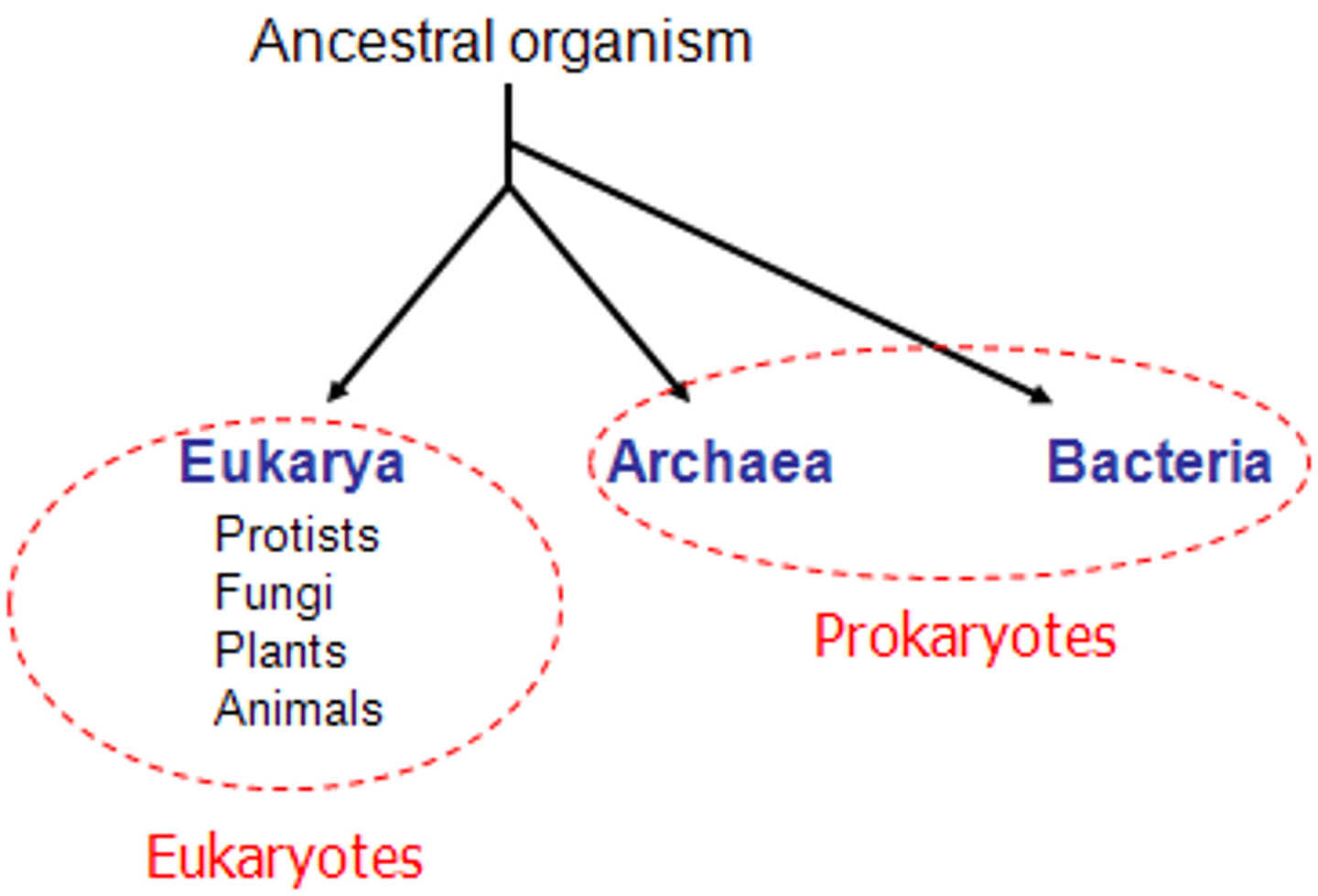
What makes something a Prokaryote versus a Eukaryote?
A Prokaryote ("before nuclues") doesn't have a nucleus while a Eukaryote does.

CRB Instead of having a Nucleus, what is the name of where the DNA is concentrated in Prokaryotes?
(A) Nucleolus
(B) Nucleoid Region
(C) Transcriptional Region
(D) Nucleic Acid Pool
(B) Nucleoid Region
The Nucleoid Region is where the DNA is concentrated in Prokaryotes.
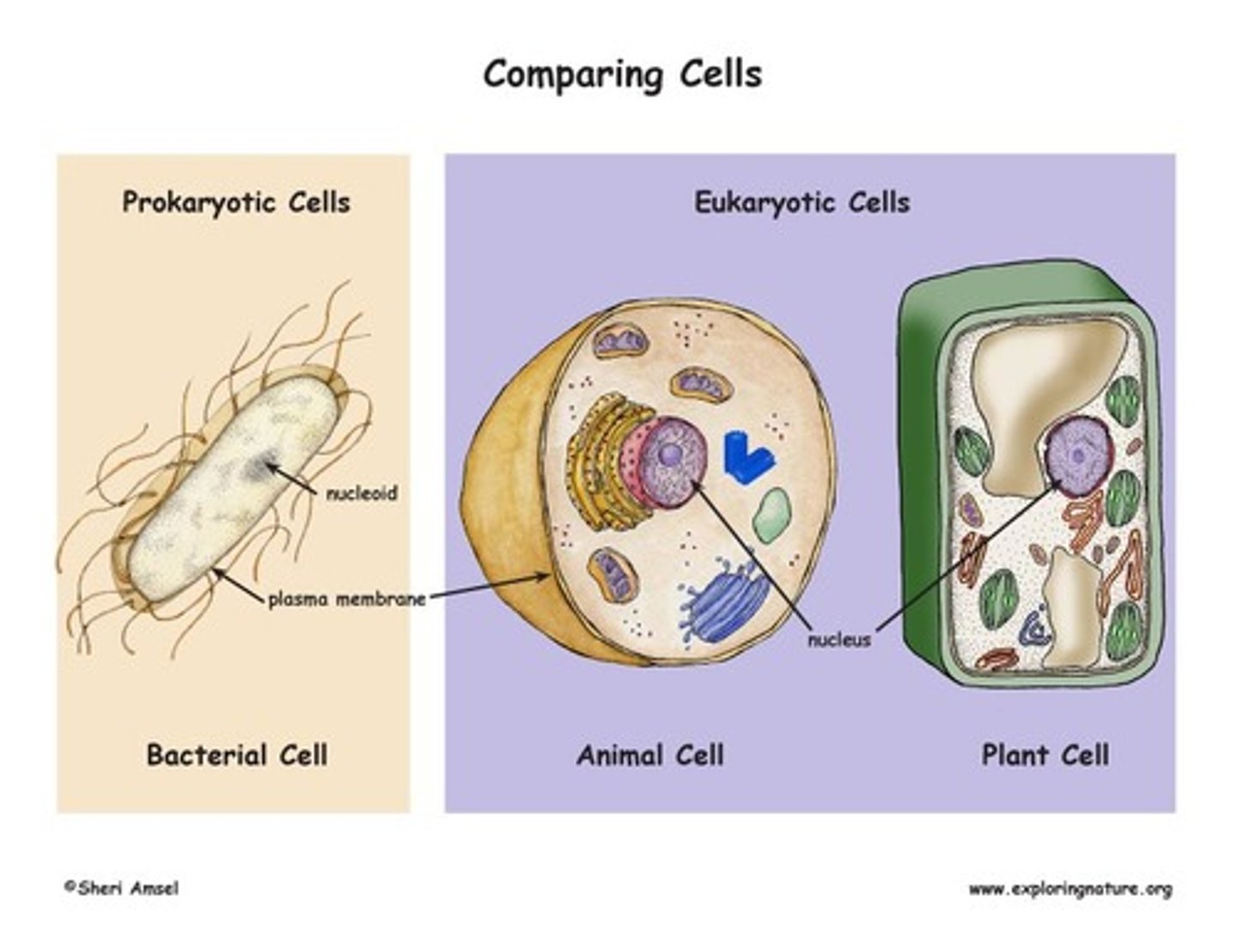
Archaea are the most ancient of the three main types of basic organisms. Why are they known as "extremophiles"?
Archaea are known as "extremophiles" because they "love" harsh environments such as the ones that existed on the primitive earth.
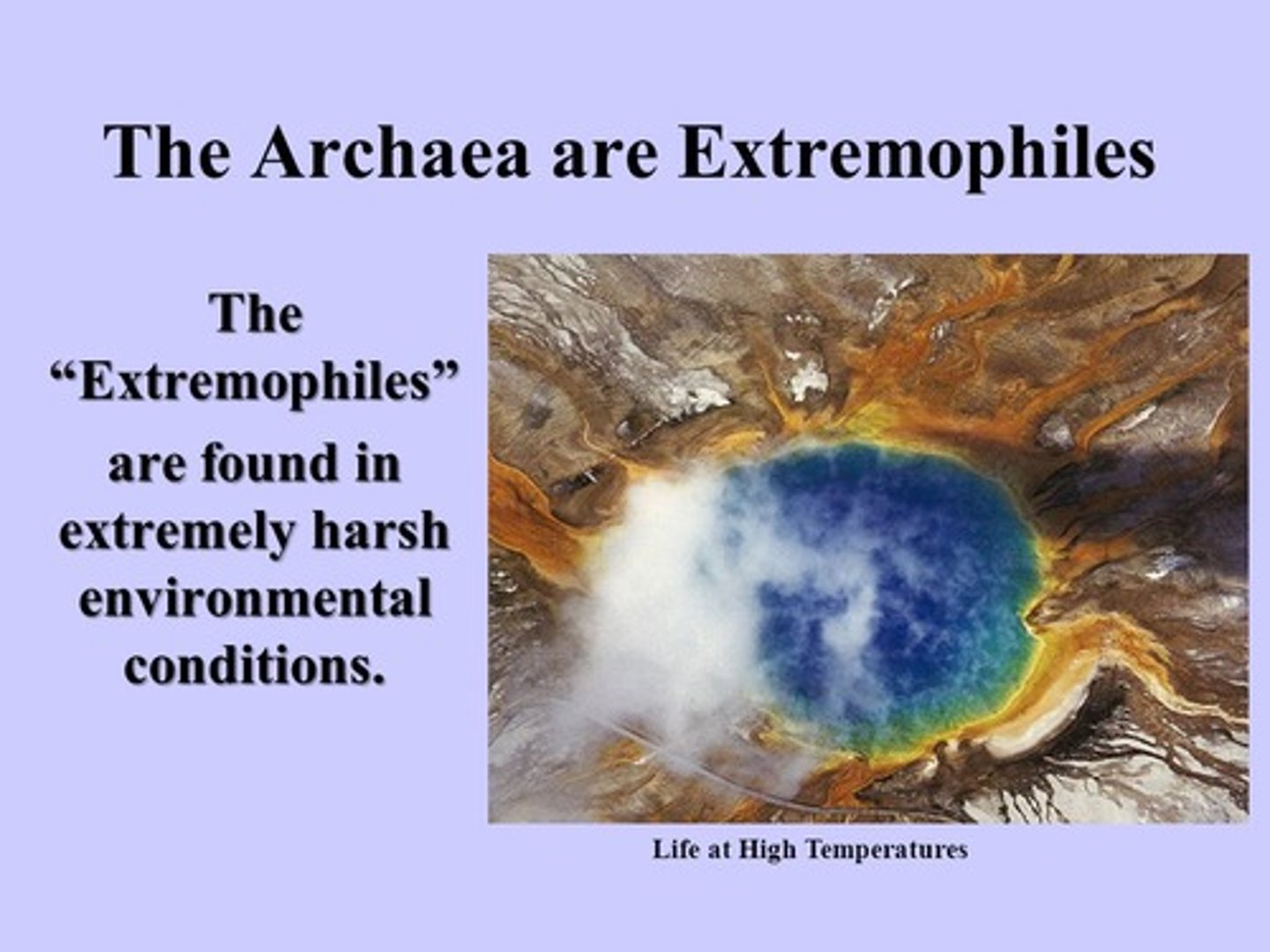
Compare the three types of "extremophiles":
(1) Thermophiles
(2) Halophiles
(3) Methanogens
Thermophiles love heat and extreme temperatures.
Halophiles love salty environments.
Methanogens produce methane gas ("swamp gas").

CRB True or false? Archaea may look a lot more like Bacteria, but their genes and metabolic pathways are more similar to Eukaryotes than Bacteria.
True. Archaea may look a lot more like Bacteria, but their genes and metabolic pathways are more similar to Eukaryotes than Bacteria.

CRB Which of the following is NOT one of the similarities between Archaea and Eukaryotes?
(A) They both start translation with the amino acid Methionine.
(B) They both have Histone-associated DNA.
(C) Both contain multiple chromosomes with DNA.
(D) They both use similar RNA Polymerases.
(C) Both contain multiple chromosomes with DNA.
Archaea actually have a singular, circular chromosome.
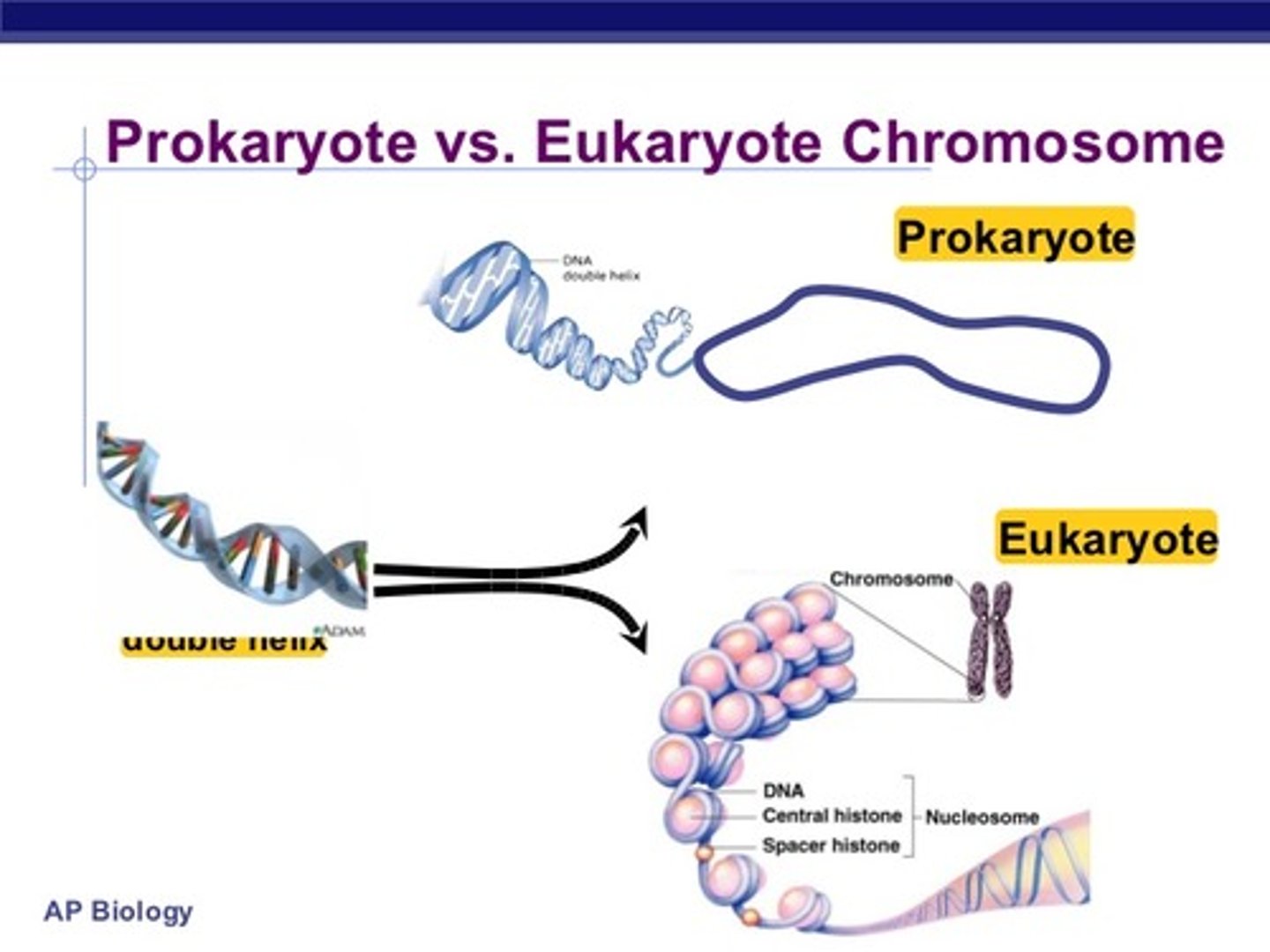
Which of the following are examples of non-photosynthesizing eukaryotes?
I. Plants
II. Fungi
III. Animals
(A) II Only
(B) III Only
(C) II and III Only
(D) I, II, and III
(C) II and III Only
Fungi and Animals are examples of non-photosynthesizing eukaryotes while Plants are an example of photosynthesizing eukaryotes.

True or false? Protozoa are single-celled organisms that share many characteristics with animals, and are considered animals.
False. Protozoa are single-celled organisms that share many characteristics with animals, but are considered protists.

Compare Fimbriae/Pili to Flagella?
Fimbriae/Pili are little hairs on the outside of some bacteria.
Flagella is the tail of a Bacteria that allows it to move.
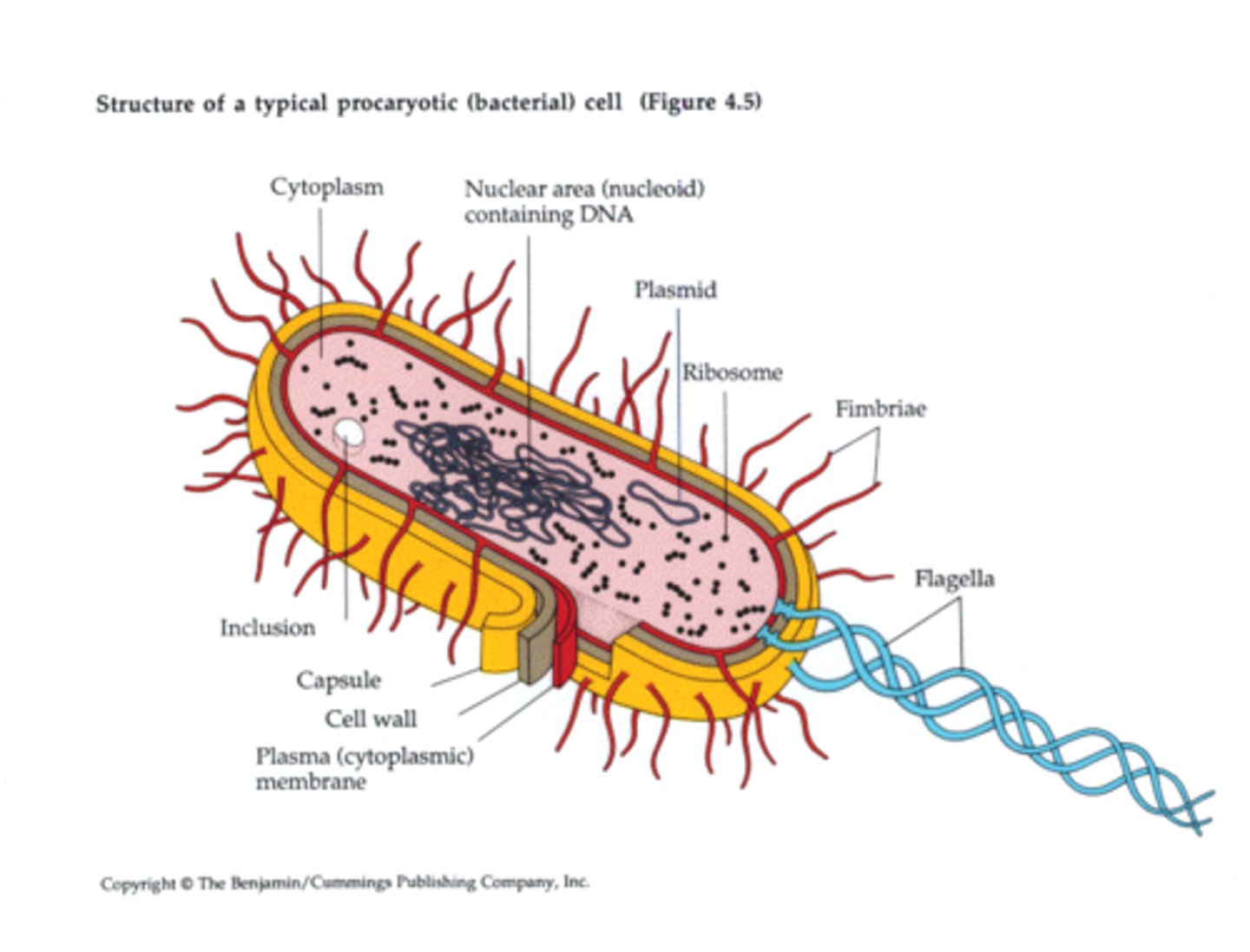
CRB Which of the following are possible targets of antibiotics that can discriminate between Bacteria and Eukaryotes?
I. Ribosomes, because Bacteria have much smaller subunits.
II. Plasma Membranes, because Eukaryotes incorporate no trans-fatty acids naturally.
III. Flagella, because the biochemical makeups of Bacterial and Eukaryotic Flagella are significantly different.
(A) I only
(B) I and III only
(C) II and III only
(D) I, II and III
(B) I and III only
Each of the following are Antibiotic Targets that can discriminate between Bacteria and Eukaryotes:
I. Ribosomes, because Bacteria have much smaller subunits.
III. Flagella, because the biochemical makeups of Bacterial and Eukaryotic Flagella are significantly different.
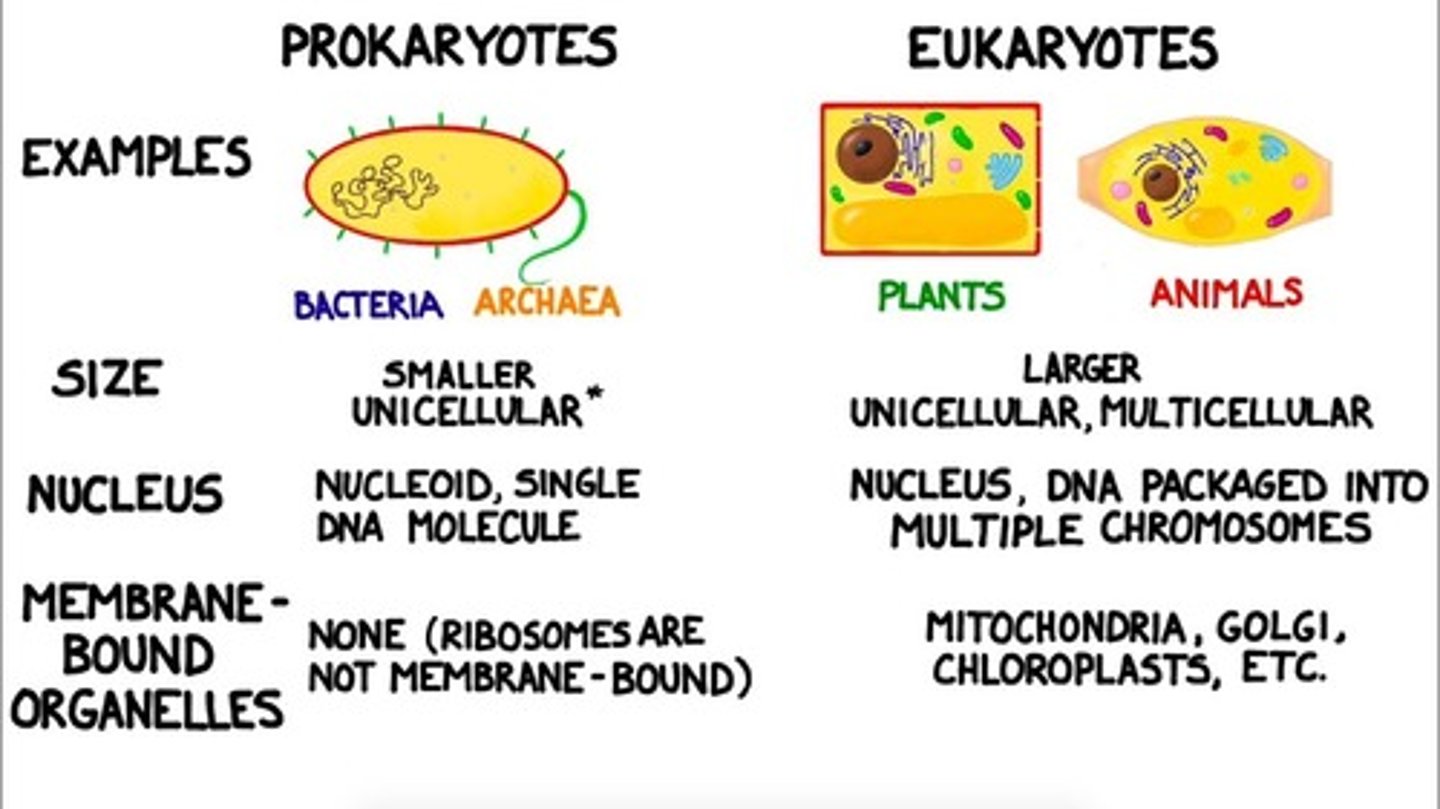
Flagella allow for Chemotaxis. What is that?
Chemotaxis is the ability of a bacteria to move in the direction of a certain chemical.
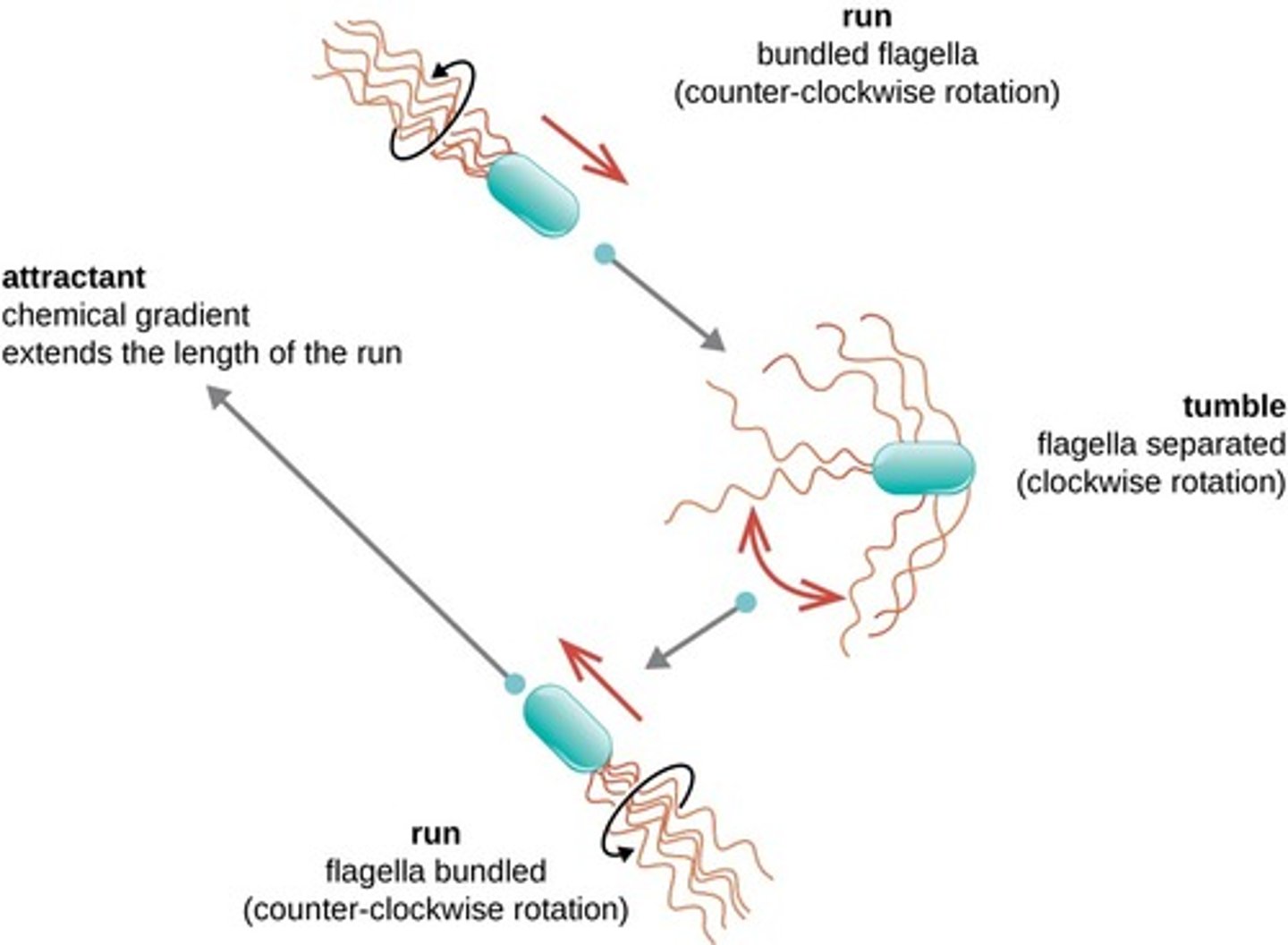
Which of the following are structures that are unique to Prokaryotes and are not held in common with Eukaryotes?
I. Nucleoid
II. Plasmid
III. Inclusion Bodies
(A) I Only
(B) I and II Only
(C) II and III Only
(D) I, II, and III
(D) I, II, and III
The following are structures that are unique to Prokaryotes and are not held in common with Eukaryotes:
I. Nucleoid
II. Plasmid
III. Inclusion Bodies
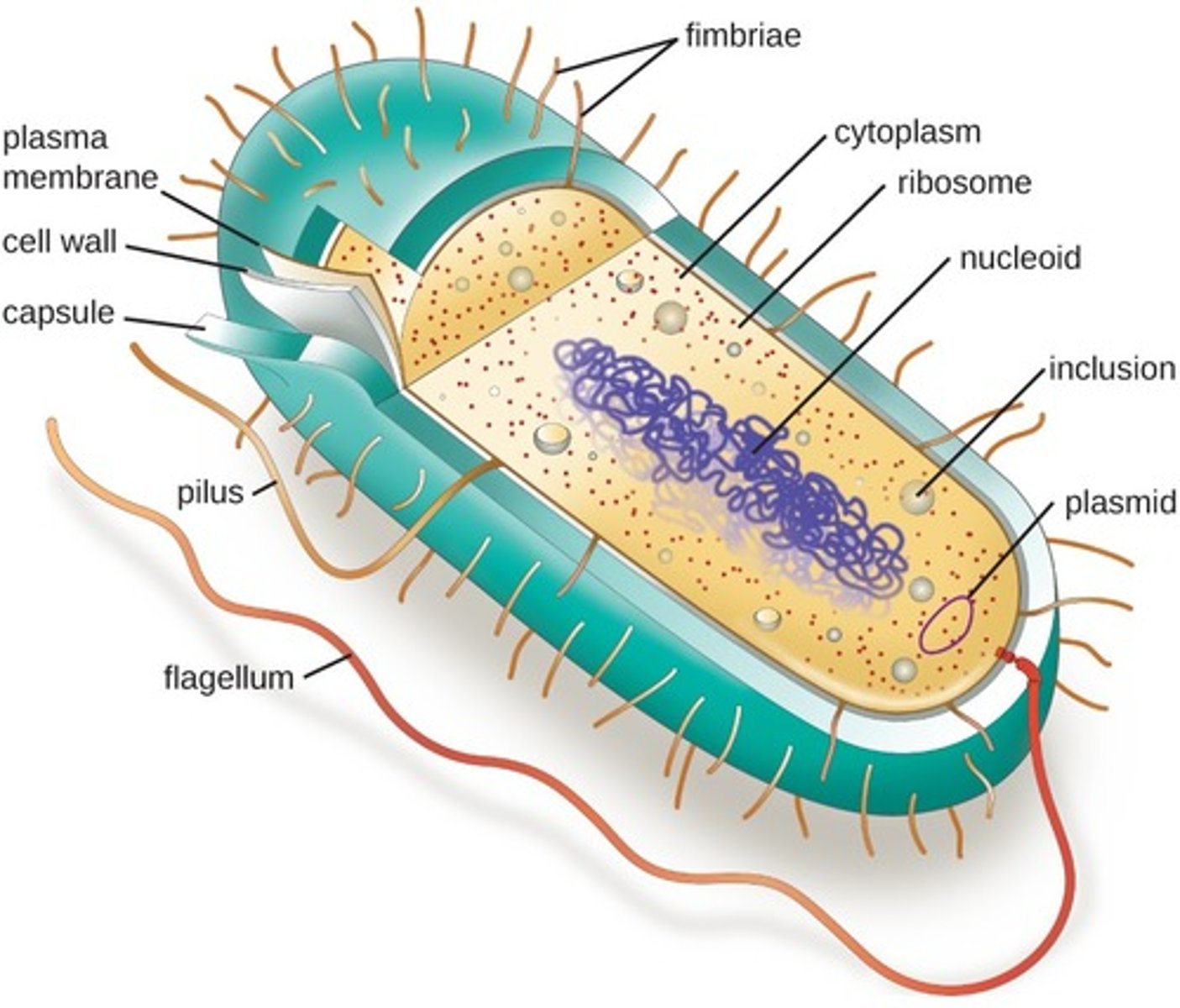
What is the structure of a Nucleoid? How does it compare to the Eukaryotic Nucleus?
A Nucleoid is a circular double-stranded piece of DNA that is free-floating in the cytoplasm.
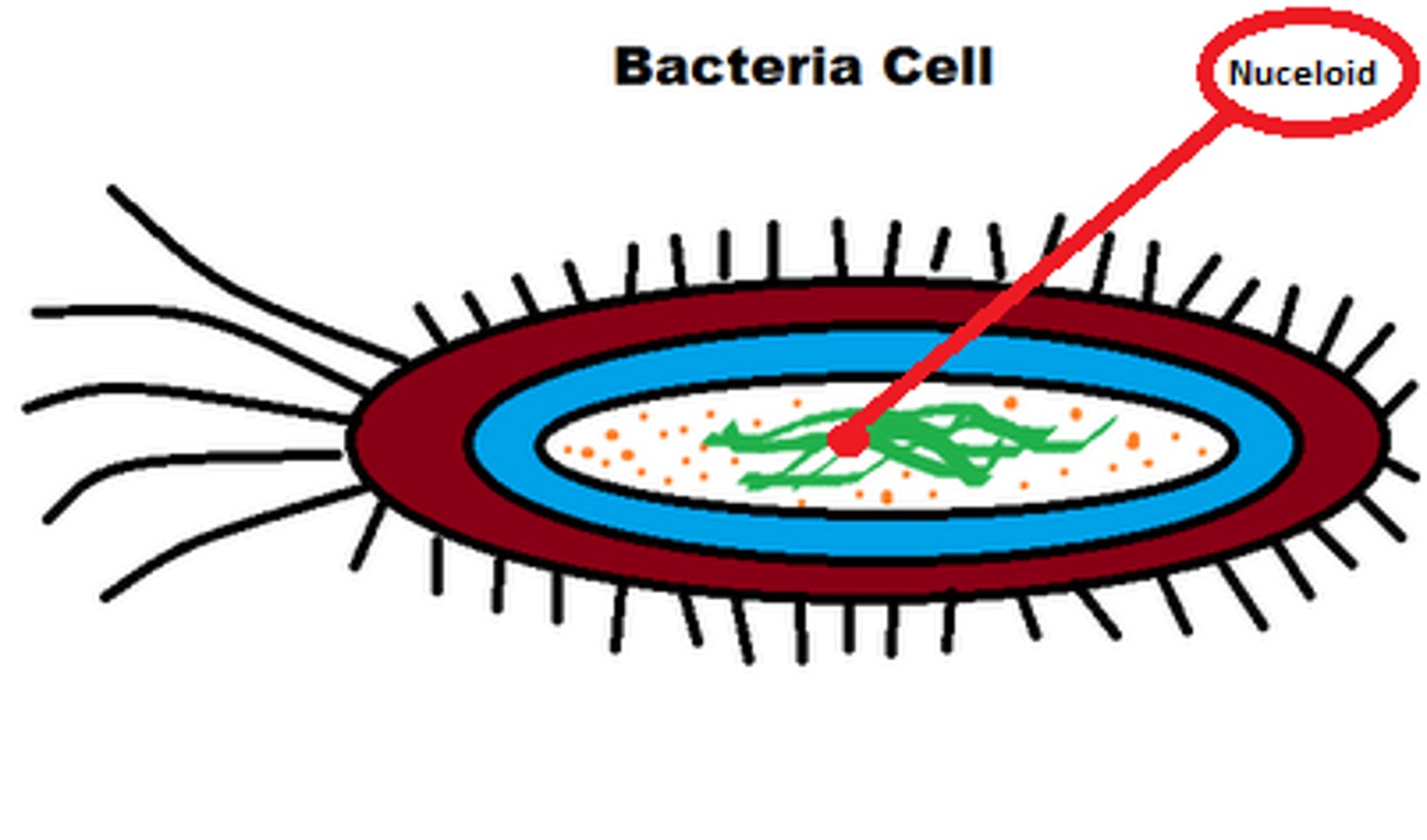
CRB Plasmids can oftentimes contain Virulence Factors, which are traits that will make the Prokaryote more Pathogenic. Which of the following is NOT a Virulent Factor?
(A) A gene coding for Projections that help the bacteria attach to cells.
(B) A trait enabling the Prokaryote to evade the host's immune system.
(C) A trait that increases toxin production.
(D) All of the above are Virulence Factors.
(D) All of the above are Virulence Factors.
Each of the following are Virulence Factors that could be passed along by Plasmids:
I. A gene coding for Projections that help the bacteria attach to cells.
II. A trait enabling the Prokaryote to evade the host's immune system.
III. A trait that increases toxin production.

What is the function of Inclusion Bodies versus Plasmids?
Inclusion Bodies store things such as nutrients.
Plasmids contain extra DNA that may provide a protection to the bacteria.
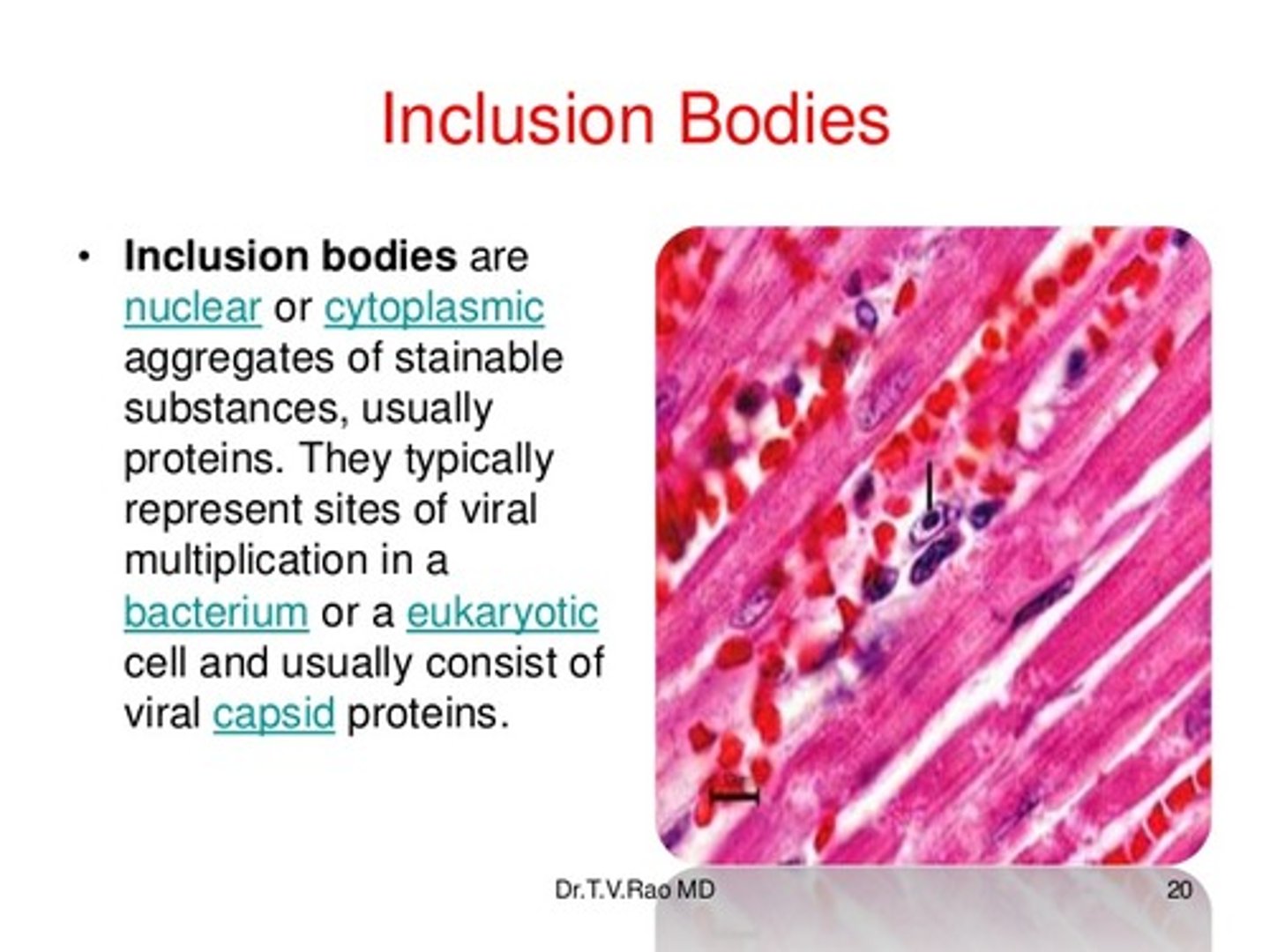
CRB True or false? Plasmid DNA is not necessary for the survival of the bacteria, so it is not considered part of the bacteria's genome.
True. Plasmid DNA is not necessary for the survival of the bacteria, so it is not considered part of the bacteria's genome.
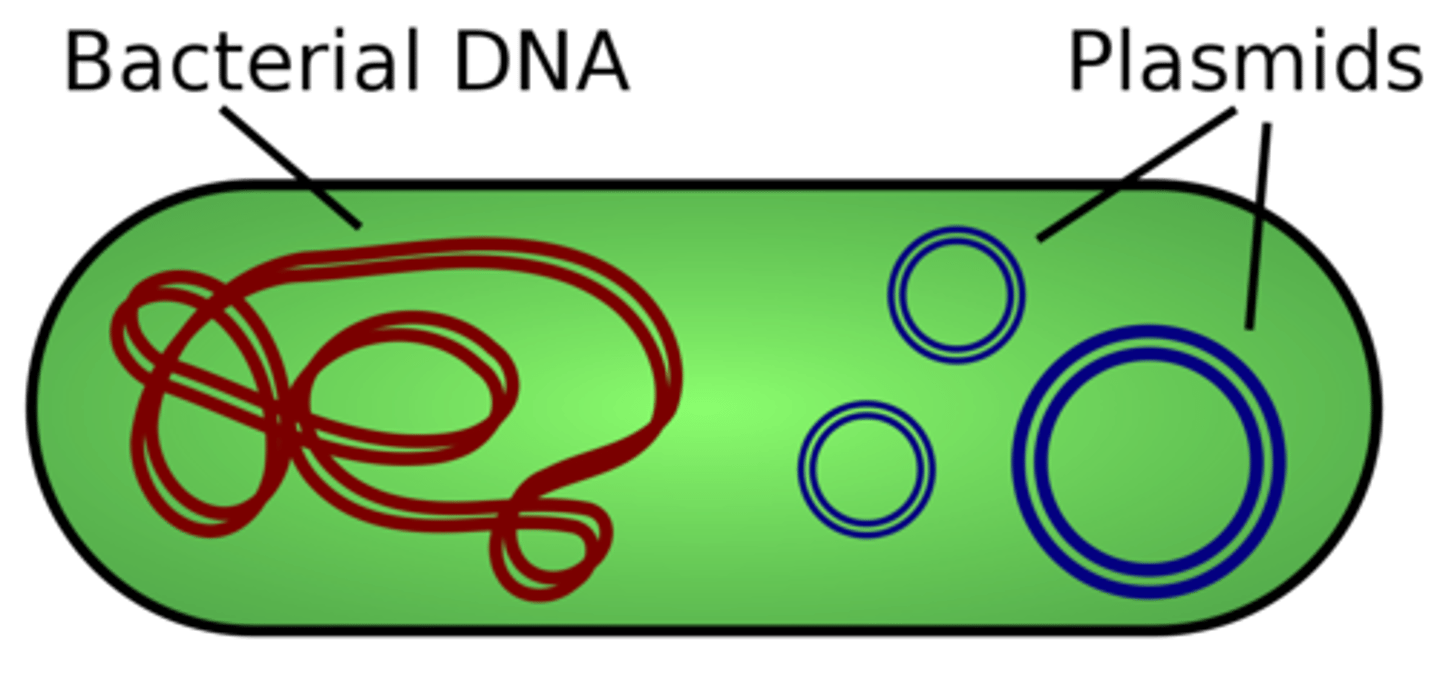
CRB It is well-known that Bacteria and the human body have a complex relationship. Which of the following statements about their relationship is FALSE?
(A) Bacteria cells outnumber the human body cells by a factor of 10.
(B) Some bacteria produce necessary compounds for humans, like Vitamins E and Biotin (B7).
(C) Some bacteria are Mutualistic Symbiotes, meaning both the bacteria and humans benefit from interacting.
(D) Some pathogenic bacteria can live extracellularly or intracellularly.
(B) Some bacteria produce necessary compounds for humans, like Vitamins E and Biotin (B7).
Bacteria actually produce Vitamin K and B7 for humans in the human gut.
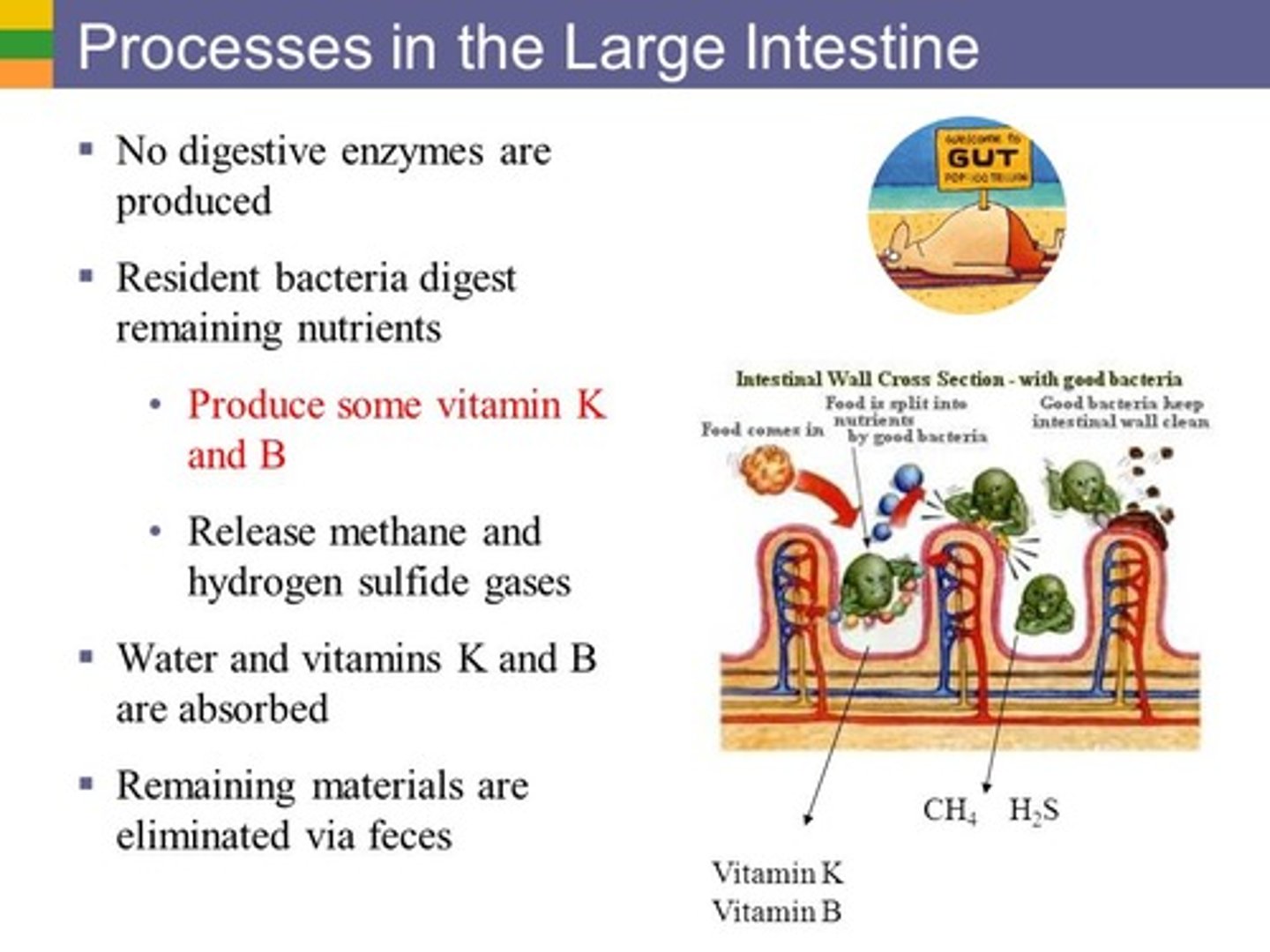
Compare the following shapes of bacteria: Cocci (sing. "Coccus"), Bacilli (sing. "Bacillus"), and Spirilla (sing. "Spirochete").
Cocci are sperically shaped.
Bacillus are rod-shaped.
Spirilla are long and skinny squiggles.
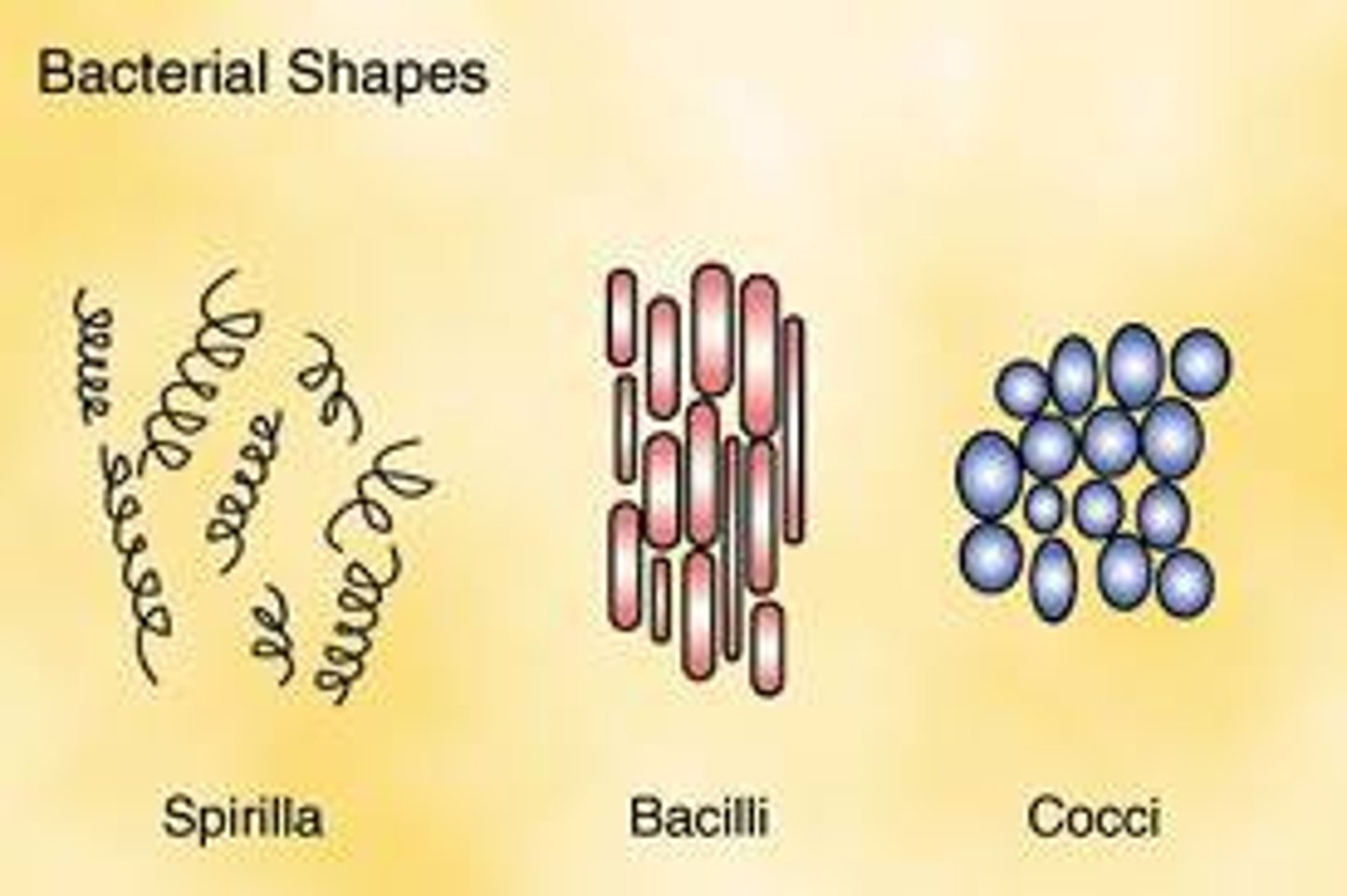
CRB Bacteria can also be classified into two major groups based on the environmental conditions they need for their metabolism. What are these classifications?
(A) Ahydrogenic and Hydrogenic
(B) Asulfuric and Sulfuric
(C) Anaerobic and Aerobic
(D) Anitrogenic and Nitrogenic
(C) Anaerobic and Aerobic
Bacteria can be classified into Anaerobic or Aerobic, based on if they require Oxygen for their metabolism.
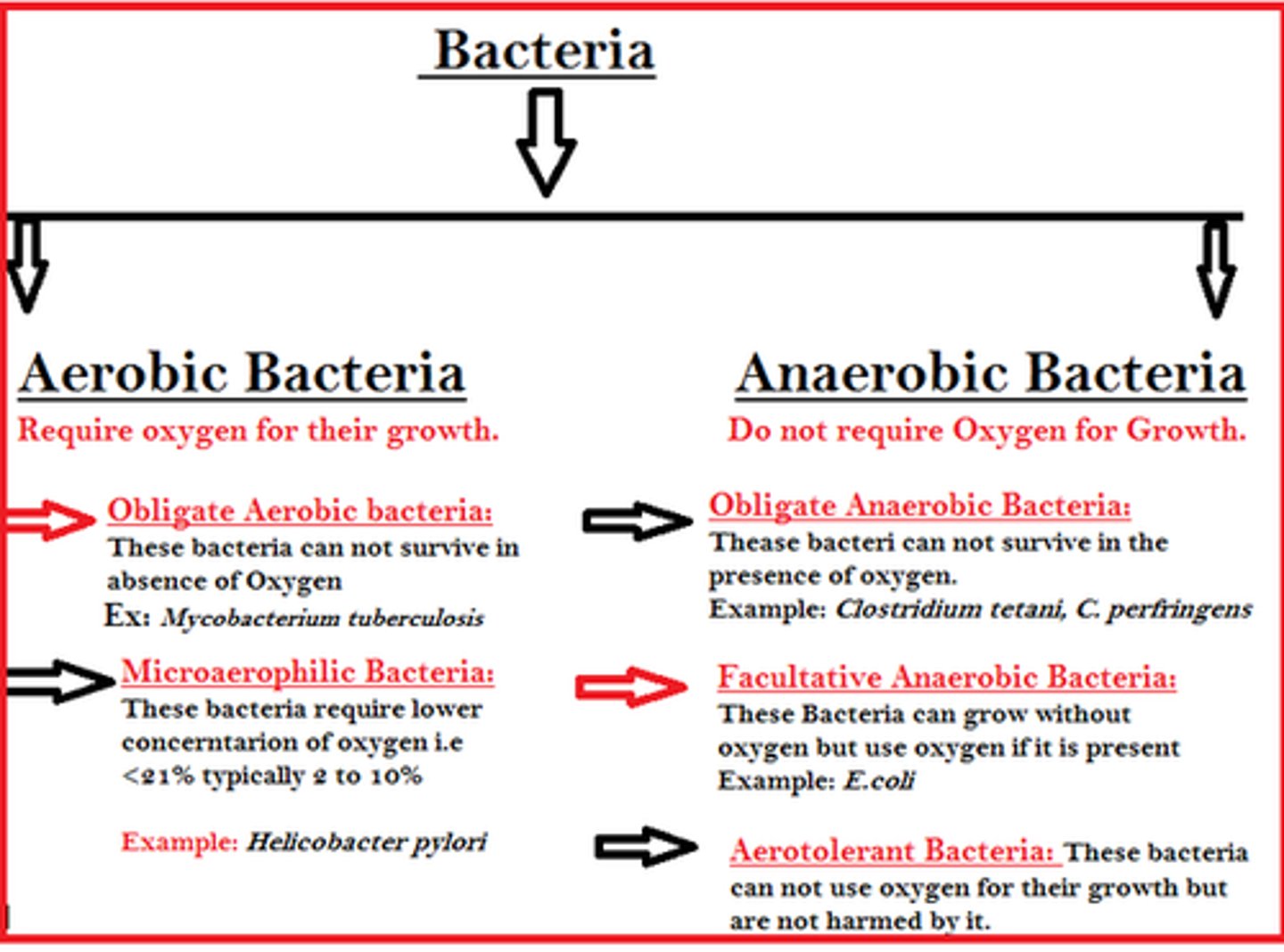
CRB Which of the following can use Oxygen for their metabolism?
I. Obligate Aerobes
II. Aerotolerant Anaerobes
III. Facultative Anaerobes
(A) I only
(B) I and II only
(C) I and III only
(D) I, II and III
(C) I and III only
Obligate Aerobes and Facultative Anaerobes can use Oxygen in their Metabolic Reactions.
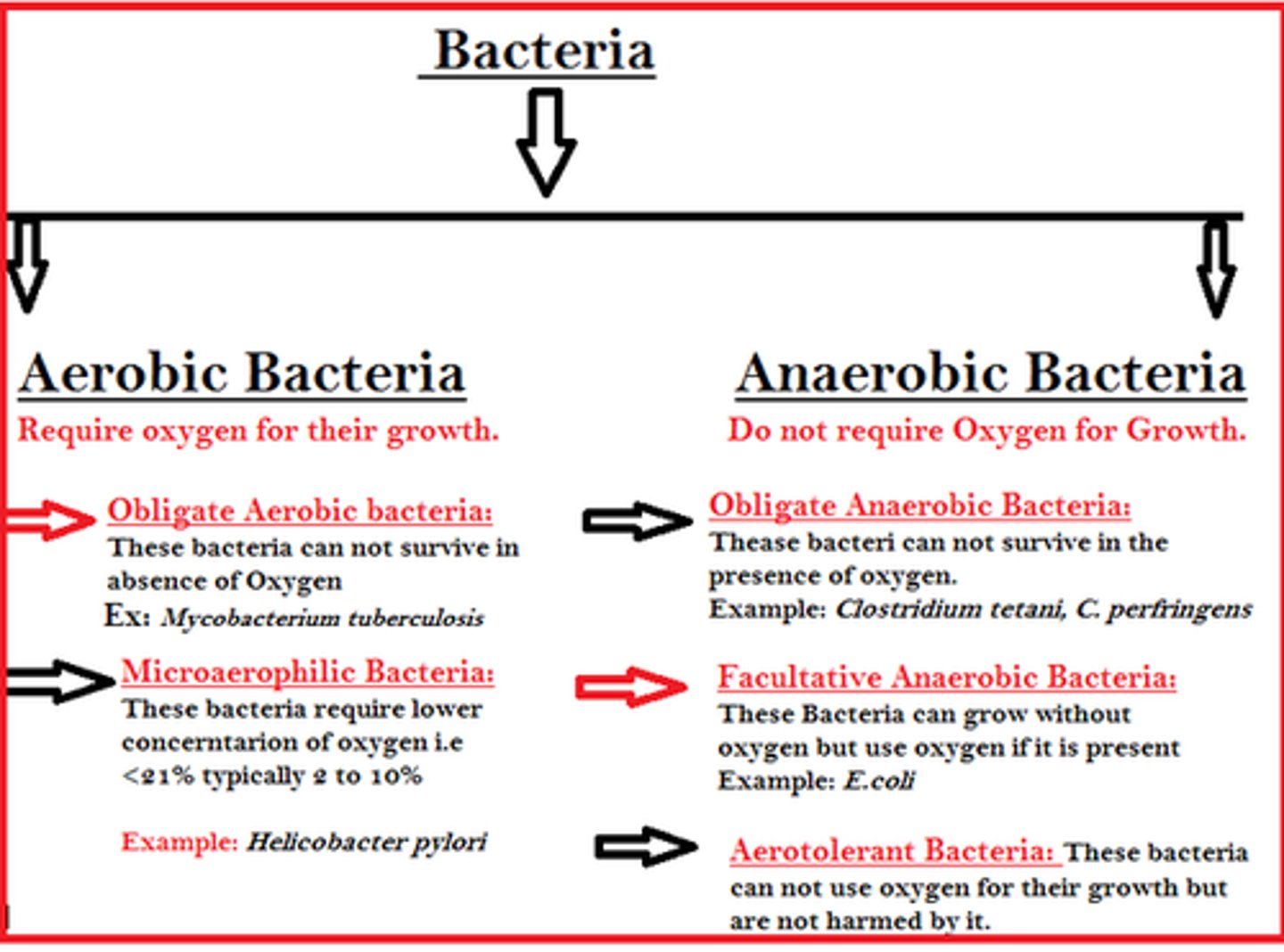
CRB Compare Obligate Aerobes and Facultative Anaerobes.
Obligate Aerobes absolutely require oxygen for their metabolism to function normally.
Facultative Anaerobes will use Oxygen if it is present, but can switch to an anaerobic metabolism if there is no oxygen.
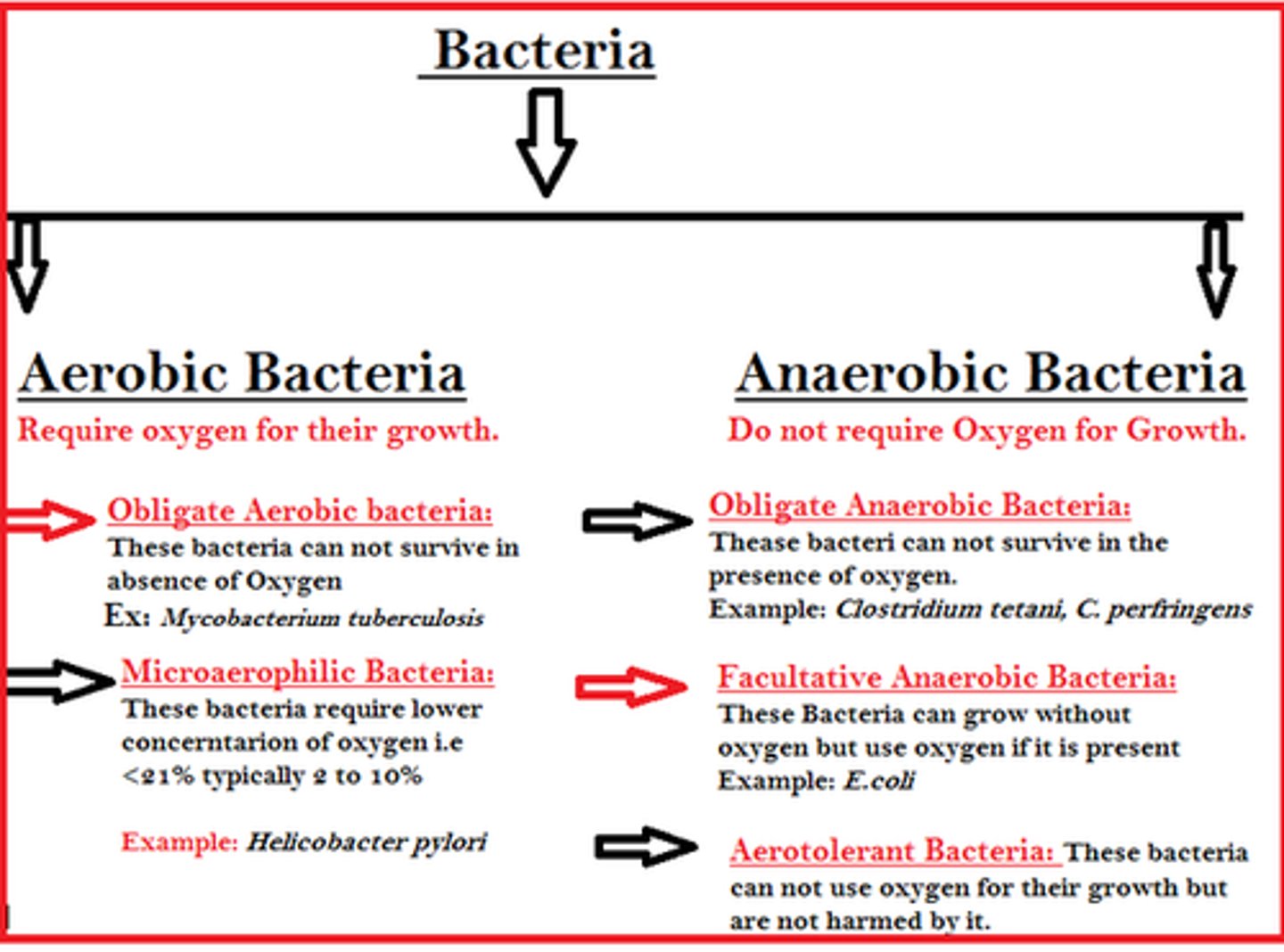
CRB Compare Aerotolerant Anaerobes and Obligate Anaerobes.
Aerotolerant Anaerobes will never use Oxygen in their metabolism, but are not hurt by having Oxygen in the environment.
Obligate Anaerobes cannot survive in Oxygenated environments, let alone incorporate Oxygen into their metabolism.

You notice purple and pink bacteria. What is the proper name for each of these bacteria types?
The purple bacteria are known as Gram-positive Bacteria.
The pink bacteria are known as Gram-negative Bacteria.
These colors appear with the addition of a specific stain.

A gram-positive bacteria has ___ layers while a gram-negative bacteria has ___ layers.
(A) 2, 3
(B) 3, 5
(C) 5, 3
(D) 3, 2
(B) 3, 5
A gram-positive bacteria has 3 layers while a gram-negative bacteria has 5 layers.
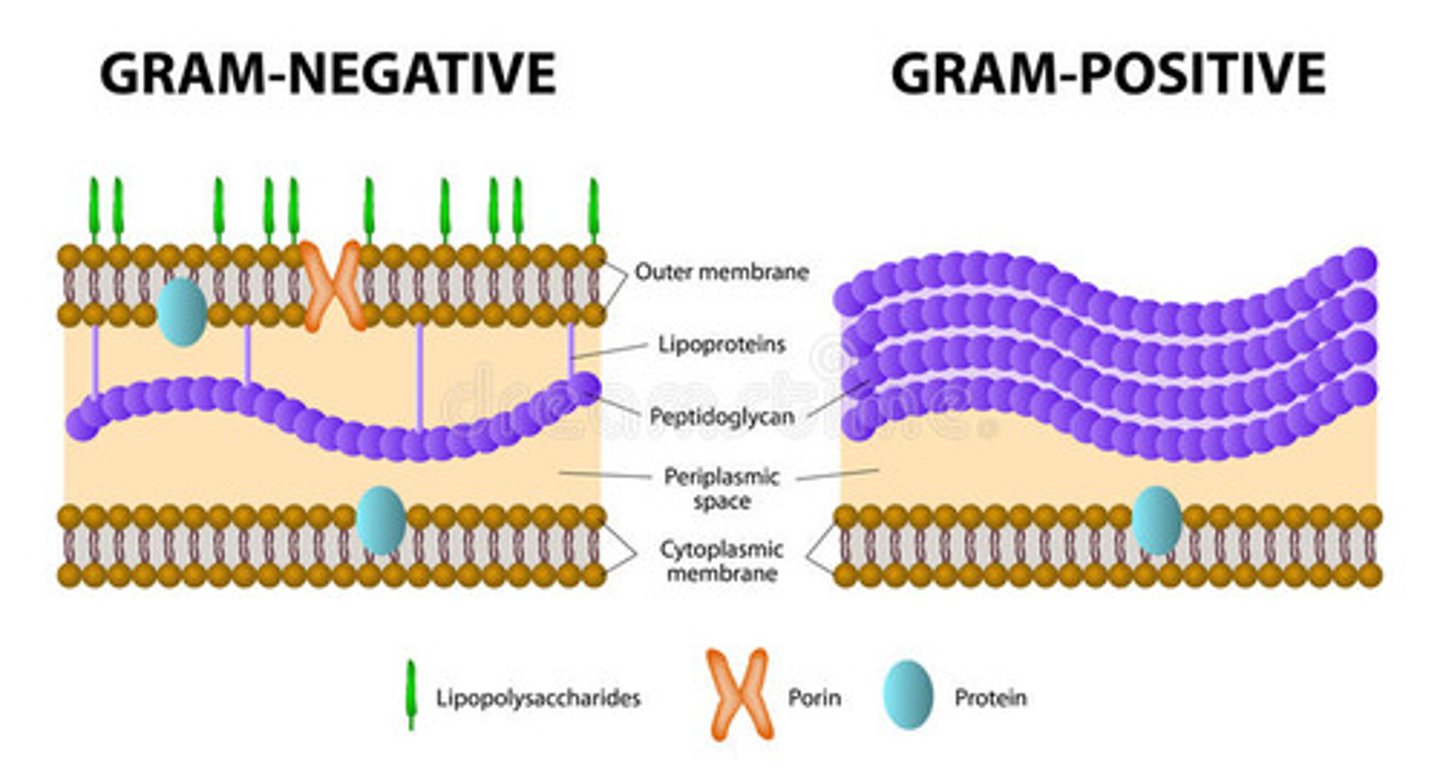
What special layer does a gram-negative bacteria have that a gram-positive bacteria does not?
(A) Slime Layer/Capsule
(B) Plasma Membrane
(C) Lipopolysaccharide Layer
(D) Cell Wall
(C) Lipopolysaccharide Layer
Gram-negative bacteria have a special Lipopolysaccharide (LPS) Layer.
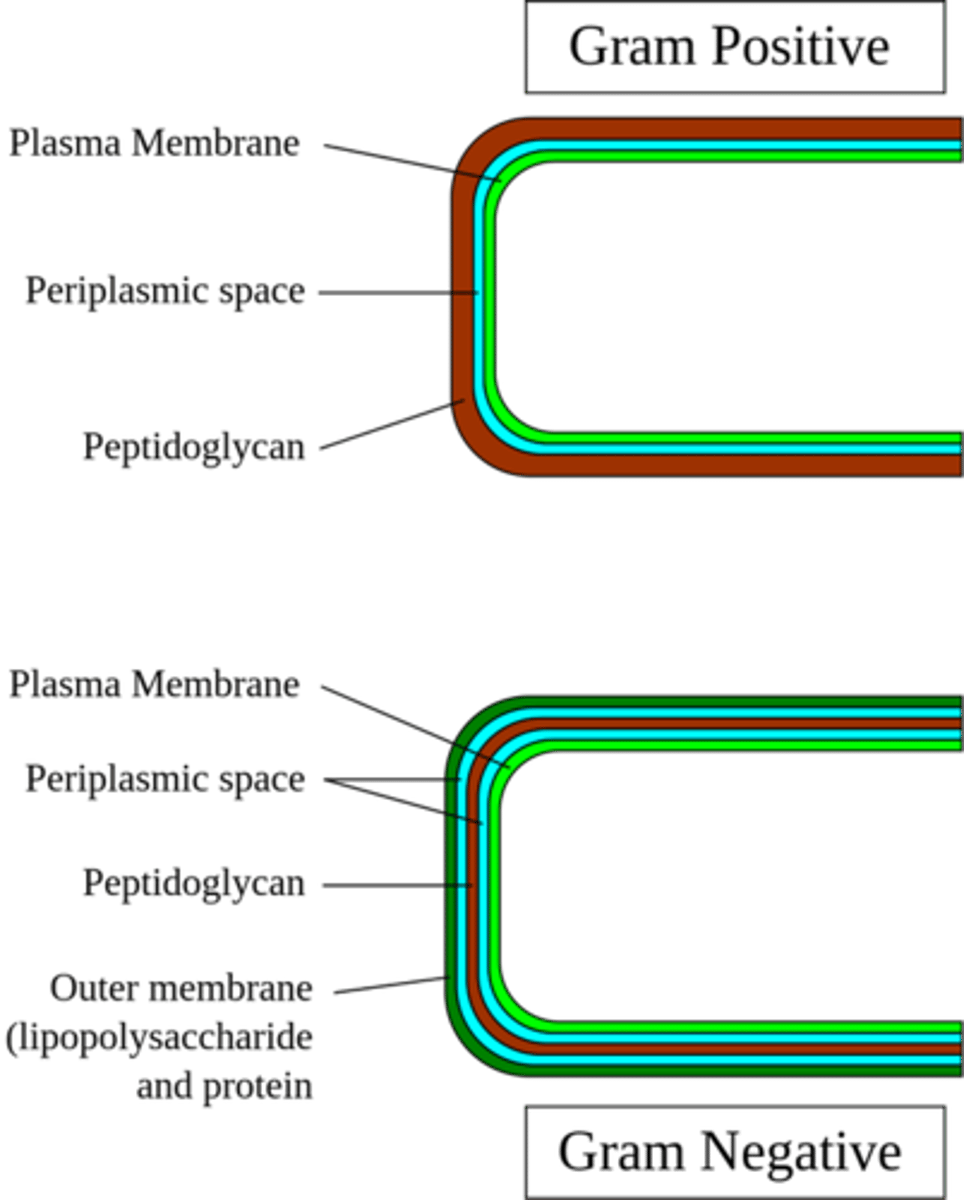
List the following layers of a gram-positive bacteria from inside to outside:
I. Slime Layer/Capsule
II. Plasma Membrane
III. Cell Wall
(A) I < II < III
(B) II < I < III
(C) III < II < I
(D) II < III < I
(D) II < III < I
The following are the layers of a bacteria from inside to outside: Plasma Membrane < Cell Wall < Slime Layer/Capsule.
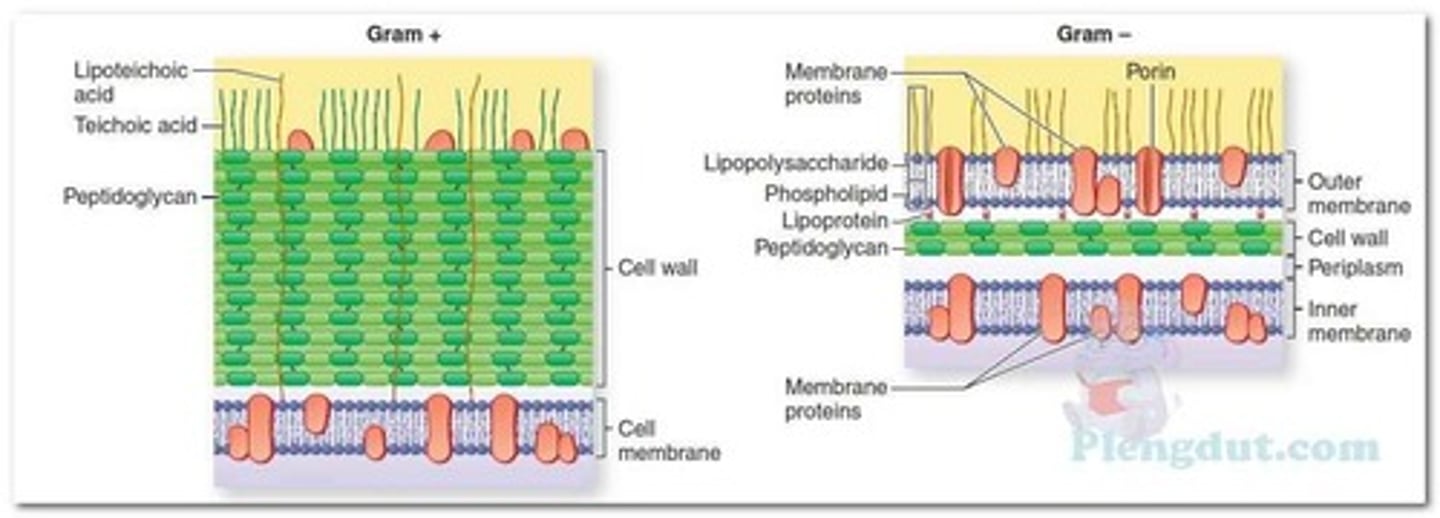
CRB True or false? Because there are no Mitochondria in Prokaryotes, their plasma membrane is used for the Electron Transport Chain and ATP synthesis.
True. Because there are no Mitochondria in Prokaryotes, their plasma membrane is used for the Electron Transport Chain and ATP synthesis.

List the following layers of a gram-negative bacteria from inside to outside:
I. Slime Layer/Capsule
II. Plasma Membrane
III. Cell Wall
IV. Lipopolysaccharide (LPS) Layer
(A) I < II < III < IV < III
(B) II < III < II < IV < I
(C) I < IV < II < IV < II
(D) III < IV < III < II < I
(B) II < III < II < IV < I
The following are the layers of a bacteria from inside to outside: Plasma Membrane < Cell Wall < Plasma Membrane < Lipopolysaccharide (LPS) Layer < Slime Layer/Capsule.

Compare the Cell Wall of a gram-positive bacteria to that of a gram-negative bacteria.
The Cell Wall of a gram-positive bacteria is much thicker than that of a gram-negative bacteria.
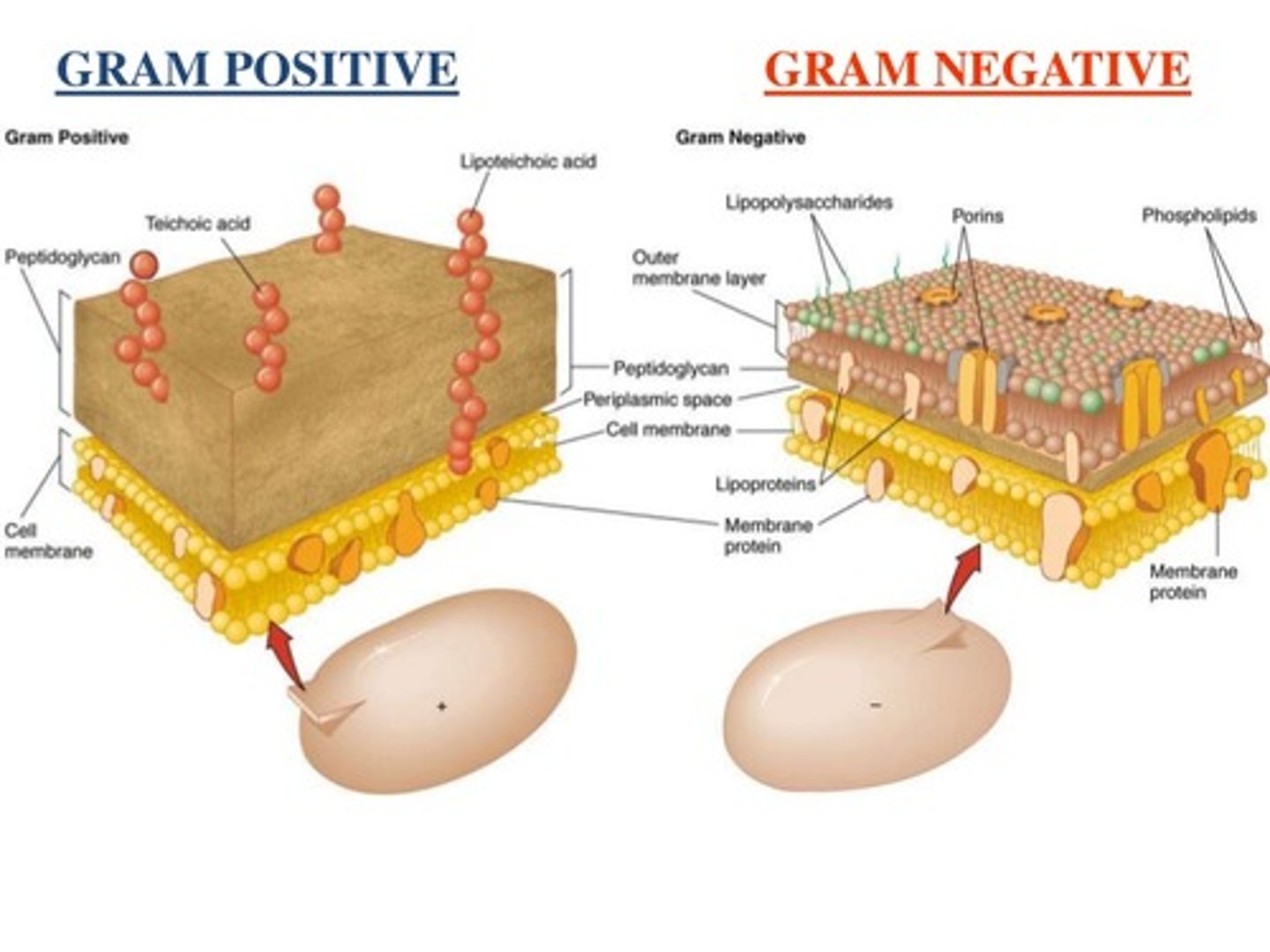
The outer layer of a Bacteria may be a Capsule or a Slime Layer. What is the difference between these two?
Slime Layers are loosely associated and can be washed off, whereas Capsules have defined boundaries and cannot be washed off.

Which of the following characteristics of a bacteria are different between gram-positive and gram-negative bacteria?
(A) Slime Layer
(B) Plasma Membrane
(C) Cell Wall
(D) Cilia
(C) Cell Wall
The Cell Wall is what differentiates gram-positive and gram-negative bacteria.
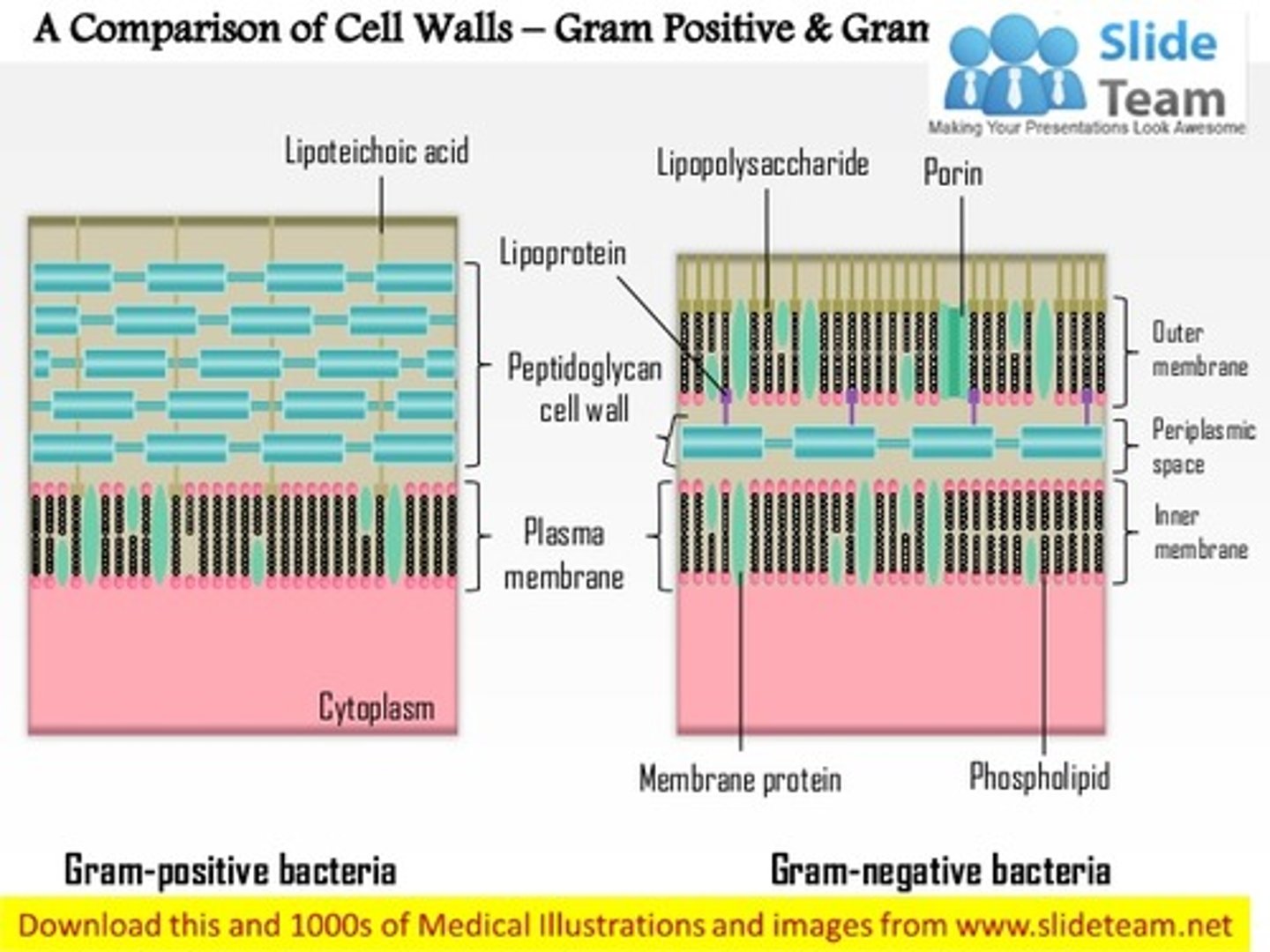
What compound is the Cell Wall of a bacteria composed of?
(A) Lipopolysaccharides
(B) Glycolipids
(C) Peptidoglycan
(D) Lipopeptides
(C) Peptidoglycan
The Cell Wall of a bacteria is composed of Peptidoglycan.
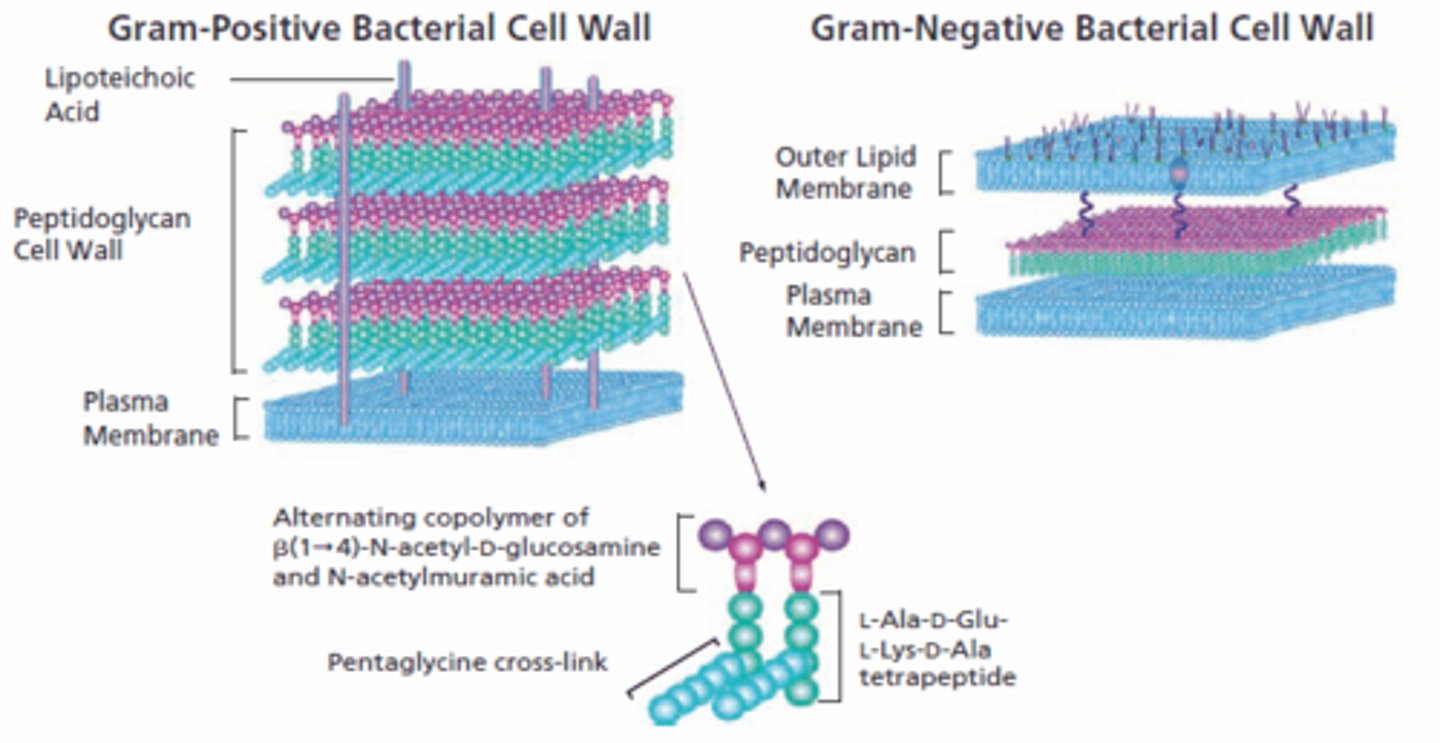
Why are gram-positive bacteria purple and gram-negative bacteria pink?
Gram stain is a purple stain. It sticks to the Cell Wall Layer composed of Peptidoglycan. This is followed by a weaker pink counter-stain, which is only visible if that purple stain does not stick.
Gram-positive bacteria will hold onto the gram stain, making them purple. Because gram-negative bacteria have so little peptidoglycan, the gram stain will essentially not stick, but rather wash right off, permitting the pink appearance from the counter-stain.
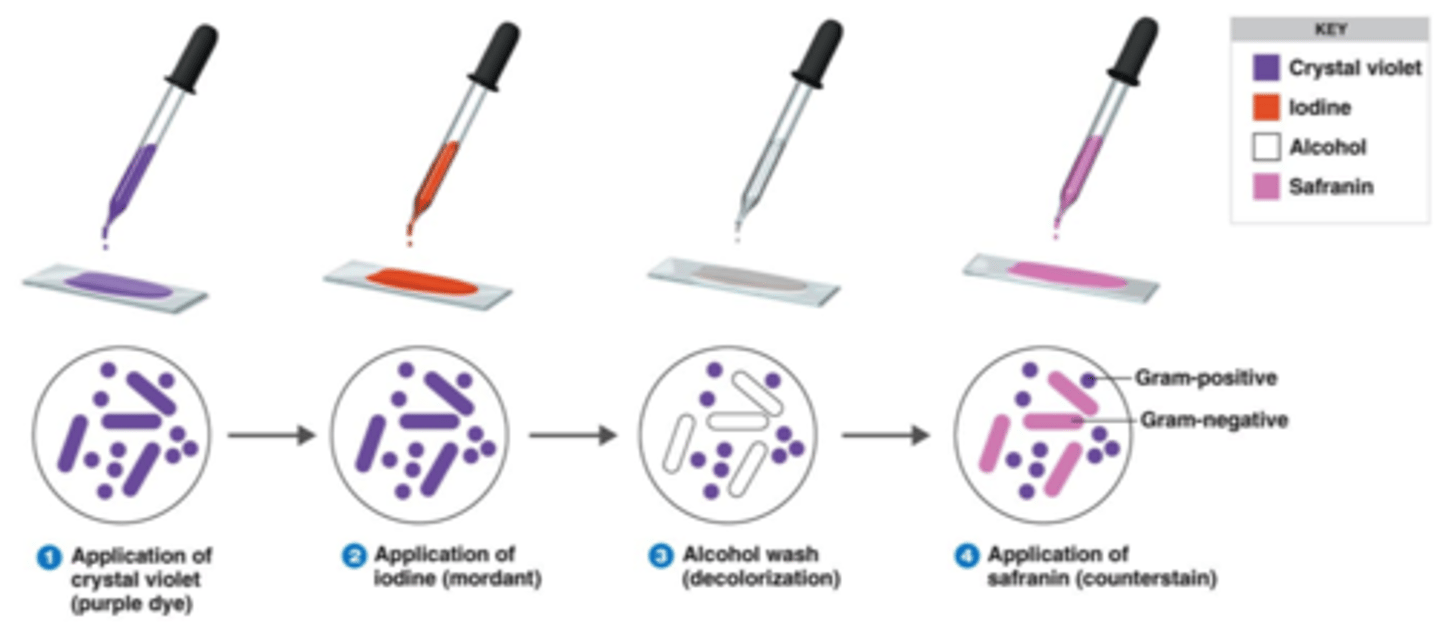
CRB Along with Peptidoglycan, what other molecule will be in Gram-Positive Cell walls? (Hint: This molecule can actually activate the human immune system)
(A) Arachidonic Acid
(B) Lipoteichoic Acid
(C) Prostaglandins
(D) MHC Class III antigens
(B) Lipoteichoic Acid
Lipoteichoic Acid is in Gram-Positive Cell Walls and can activate the Human Immune System.

Compare the processes of Transformation, Transduction, and Conjugation.
Transformation occurs when a recipient cell takes up extracellular DNA.
Transduction occurs when a virus transfers genetic material from one bacteria to another.
Conjugation occurs when one bacteria directly transmits a plasmid or other DNA to another bacteria.

Which process requires the use of a Sex Pilus? What is that?
(A) Transformation
(B) Transduction
(C) Recombination
(D) Conjugation
(D) Conjugation
Conjugation uses a Sex Pilus to transfer the genetic material directly.
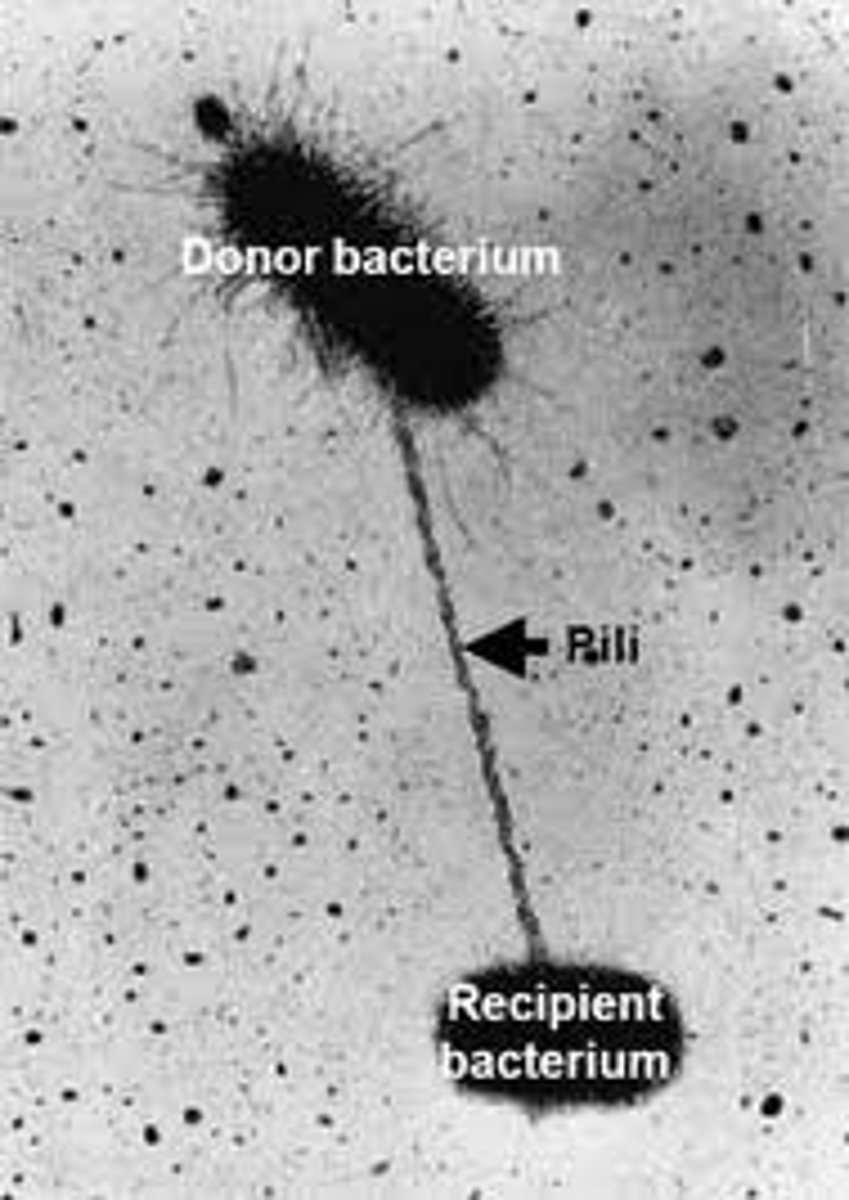
CRB Which of the following statements about Conjugation are true?
I. Conjugation is a one-direction flow of information, from a donor Male to a recipient Female.
II. Cells with the F+ Fertility Factor are the only ones able to transfer DNA to other cells.
III. Cells that have the F+ can quickly spread Virulence Factors throughout a colony, and are known as HFR cells (High Frequency of Recombination Cells).
(A) I only
(B) II only
(C) I and III only
(D) I, II and III
(D) I, II and III
Each of the following statements about Conjugation are true
I. Conjugation is a one-direction flow of information, from a donor Male to a recipient Female.
II. Cells with the F+ Fertility Factor are the only ones able to transfer DNA to other cells.
III. Cells that have the F+ can quickly spread Virulence Factors throughout a colony, and are known as HFR cells (High Frequency of Recombination Cells).
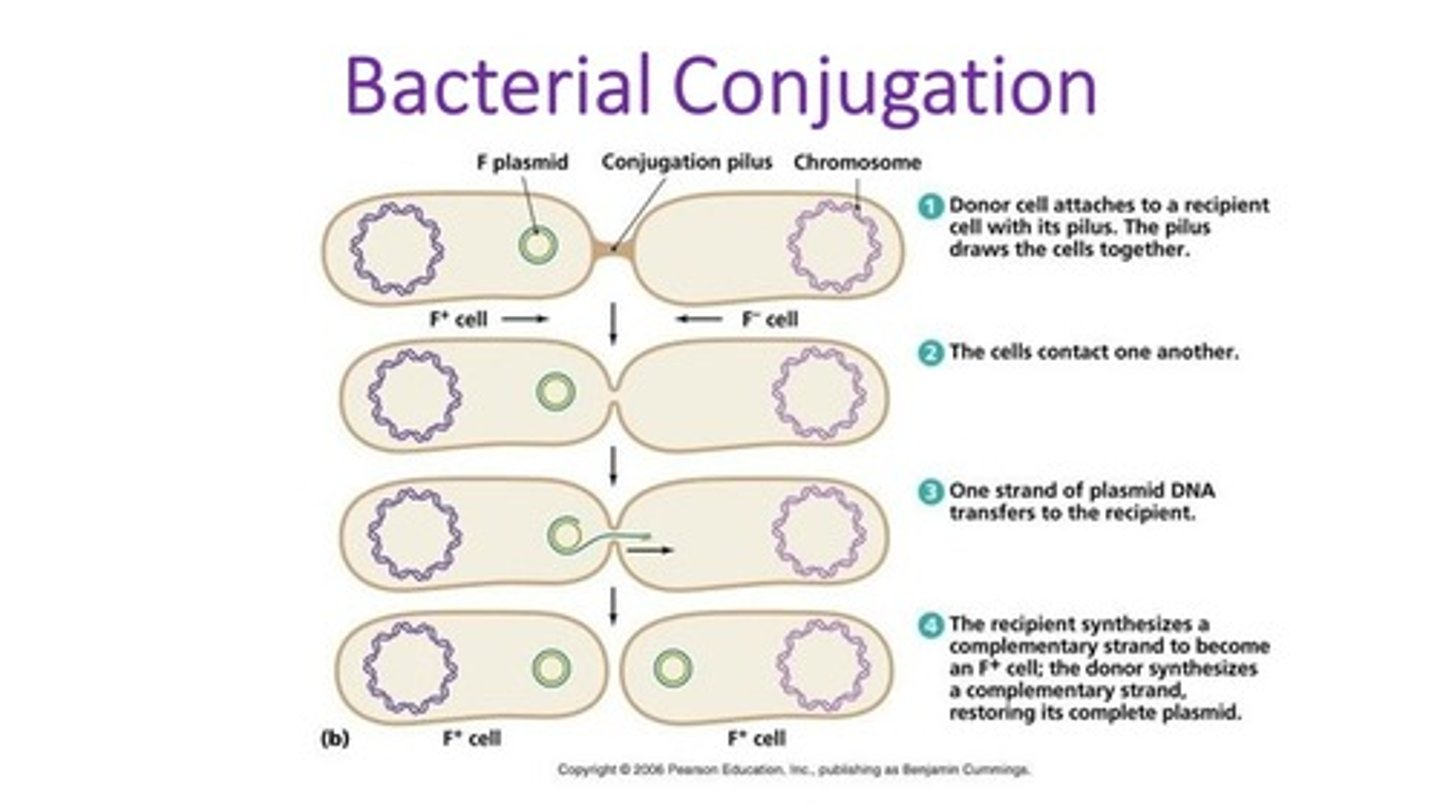
Put the following in order from smallest to largest:
I. Eukaryotic Cell
II. Virus
III. Prokaryotic Cell
(A) I < II < III
(B) II < III < I
(C) III < II < I
(D) II < I < III
(B) II < III < I
In order from smallest to largest: Virus (100x smaller than bacteria) < Prokaryotic Cell (several times smaller than Eukaryotic Cell) < Eukaryotic Cell
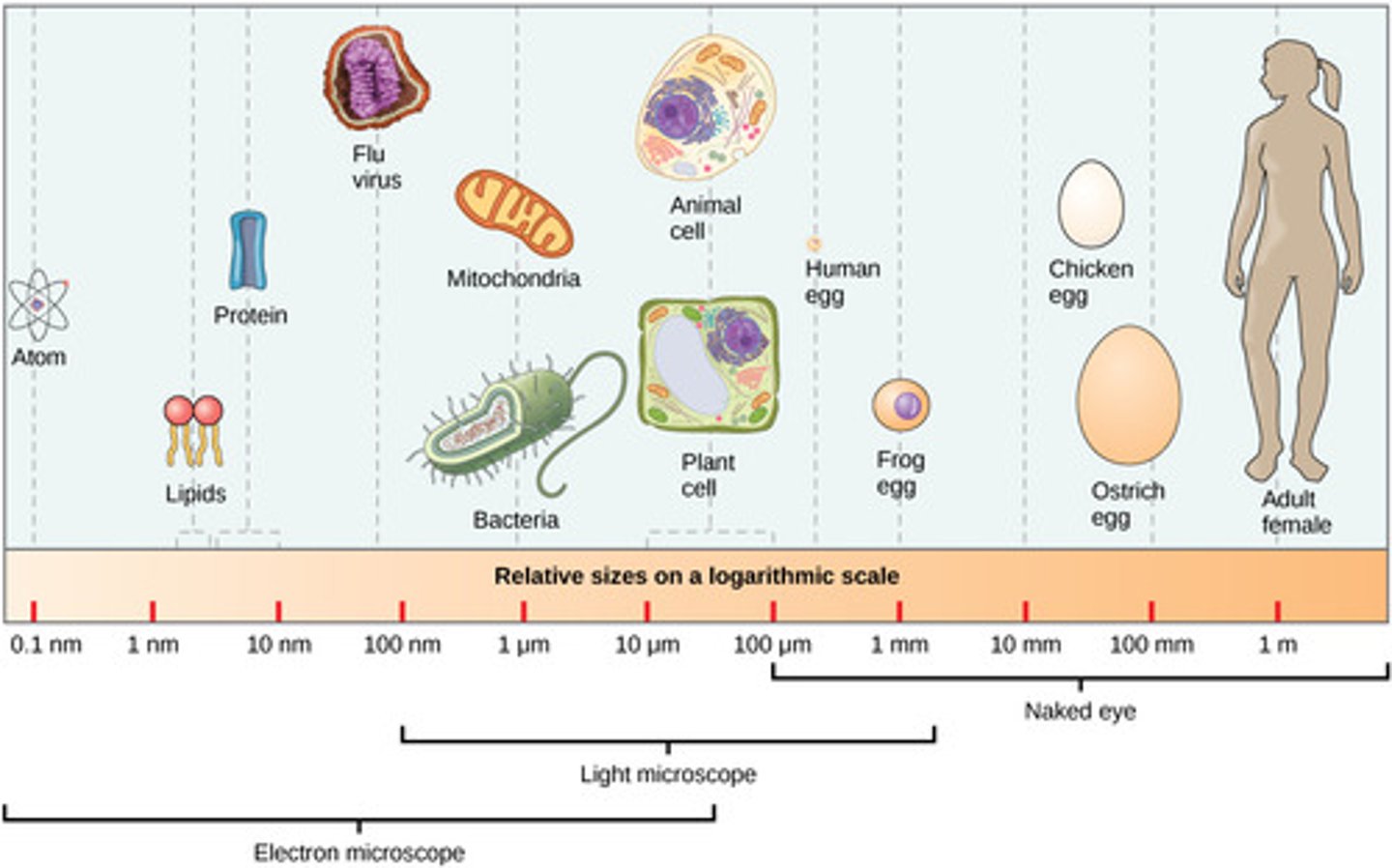
CRB Draw out a Bacterial Growth Curve, labeling the following:
- Death Phase
- Exponential Phase
- Lag Phase
- Stationary Phase
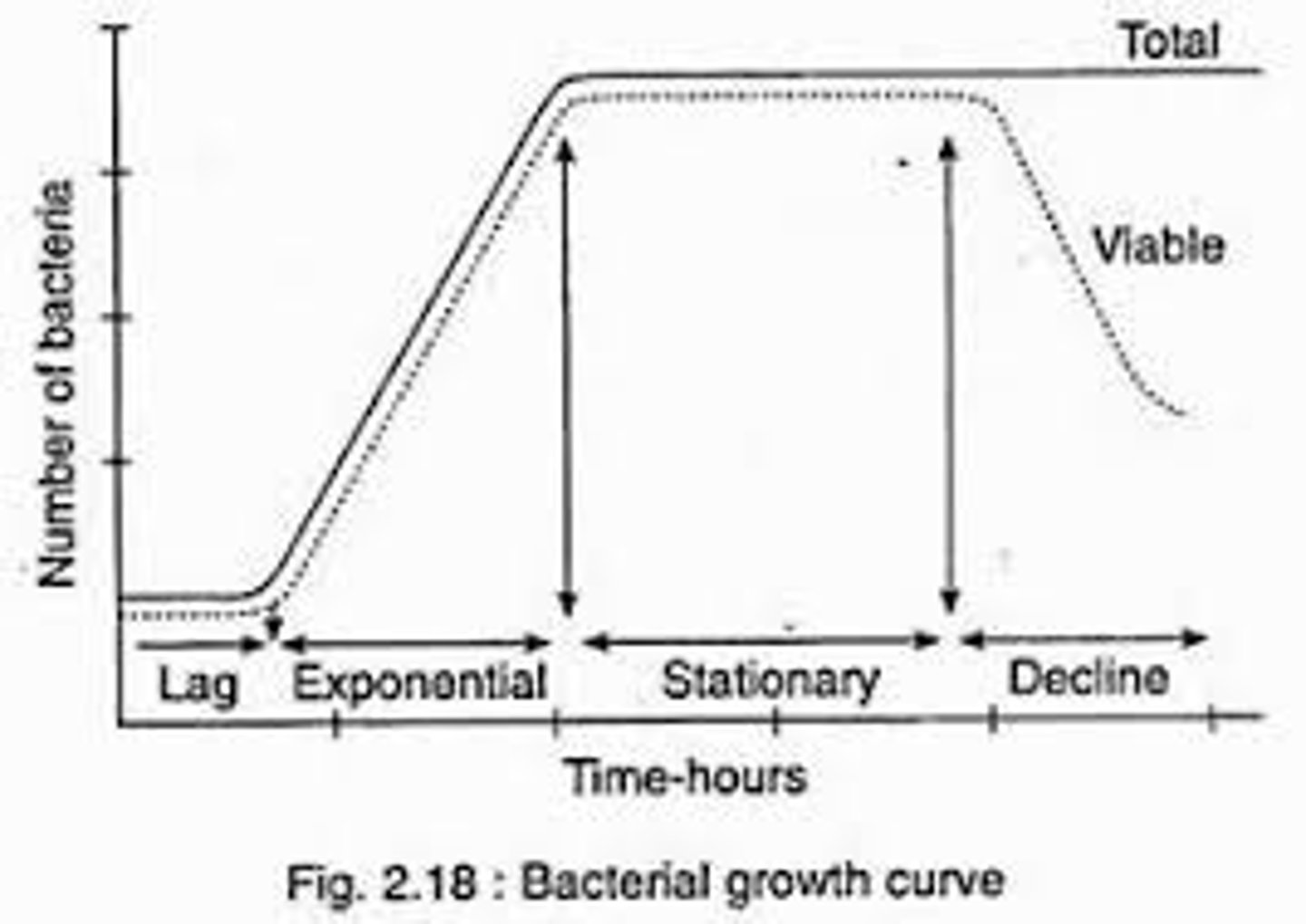
Draw a Virus, including the following terms: Nucleocapsid (head), Sheath, Tail.
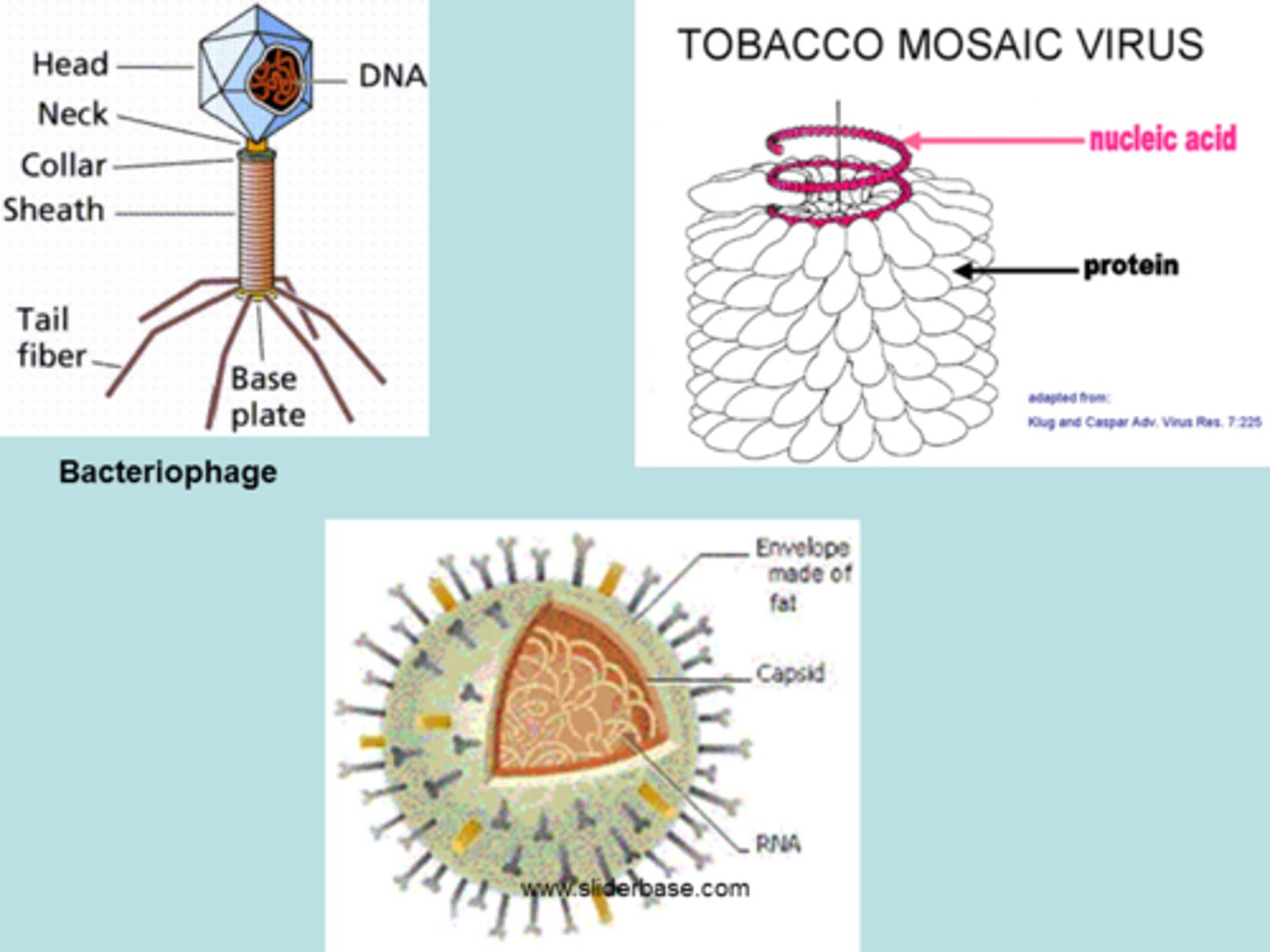
Viral Capsids are made up of little Capsomer Proteins. They are arranged in different ways, forming the two main shapes of viruses: Icosahedral, Helical. These viruses can also be enveloped or not. Draw what these viruses may look like.
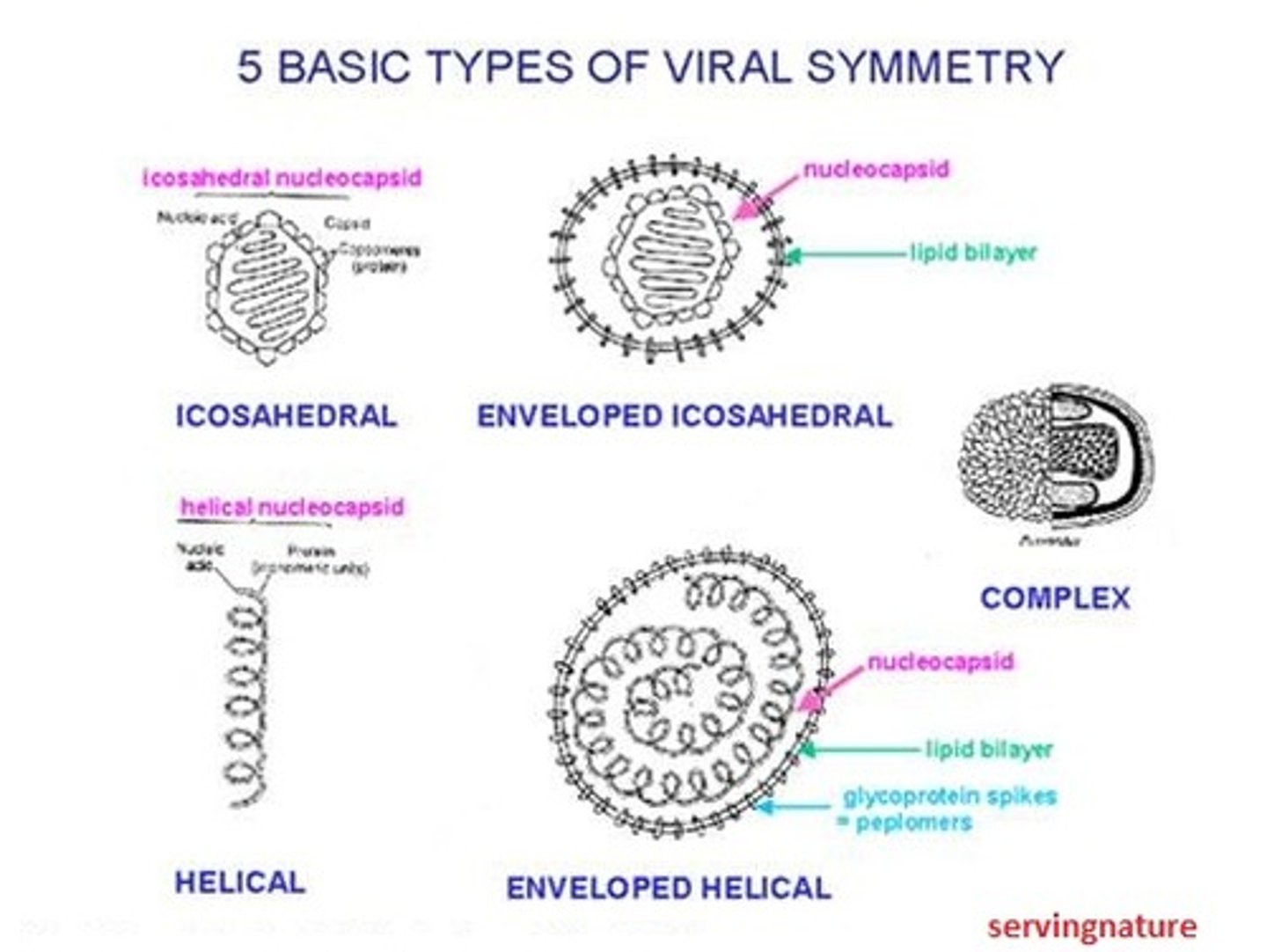
True or False? It is possible to have a Virus with dsDNA and ssRNA at the same time.
False. Viruses can be either dsDNA (Double Stranded DNA), ssDNA (Single Stranded DNA), dsRNA, or ssRNA. They cannot be more than one of these at once.
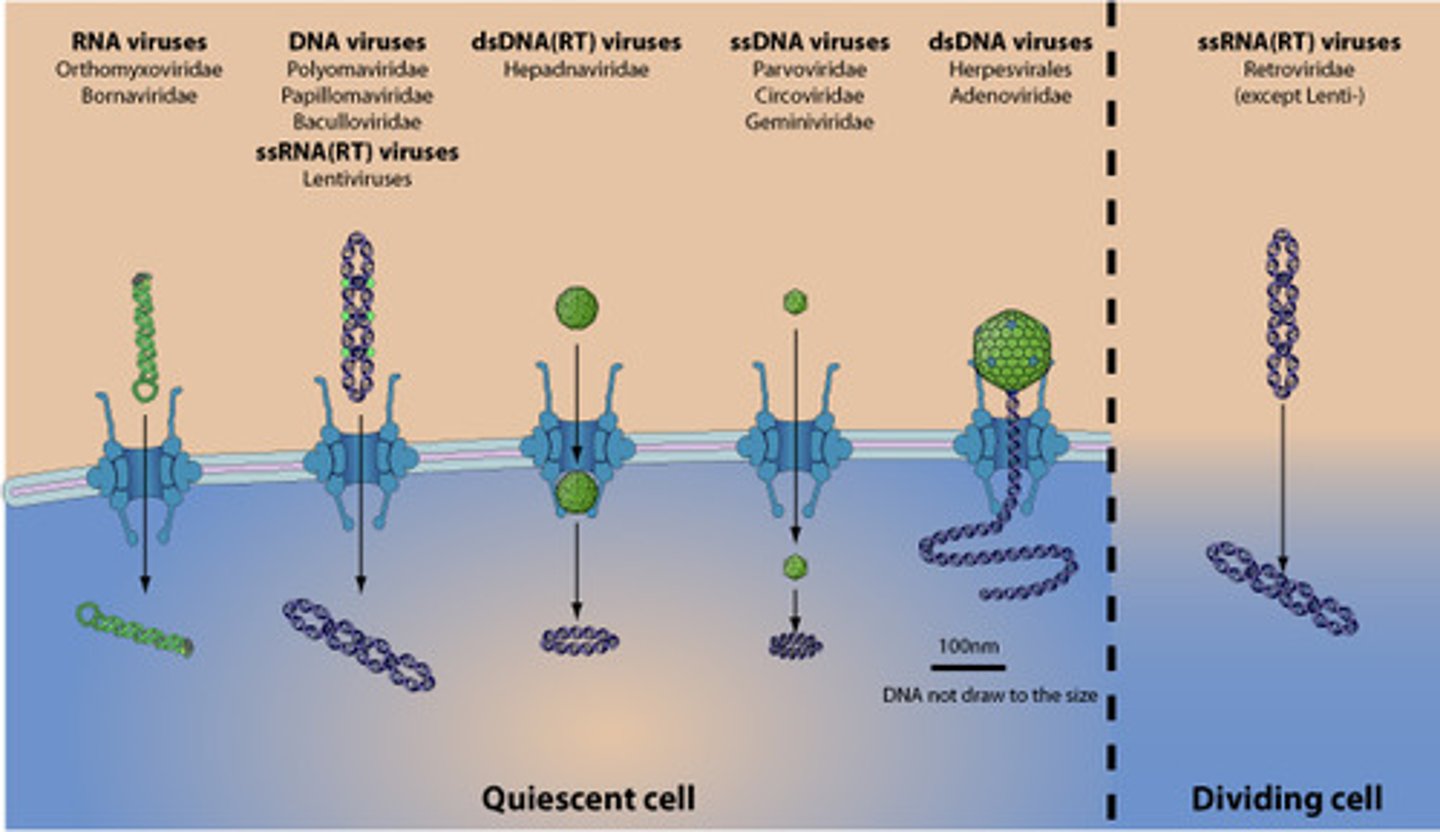
Why are Viruses known as "obligate intracellular parasites"?
Viruses cannot survive without a host ("obligate"), they need to enter the host ("intracellular"), and they use the hosts machinary without benefiting the host and often times harming the host ("parasite").
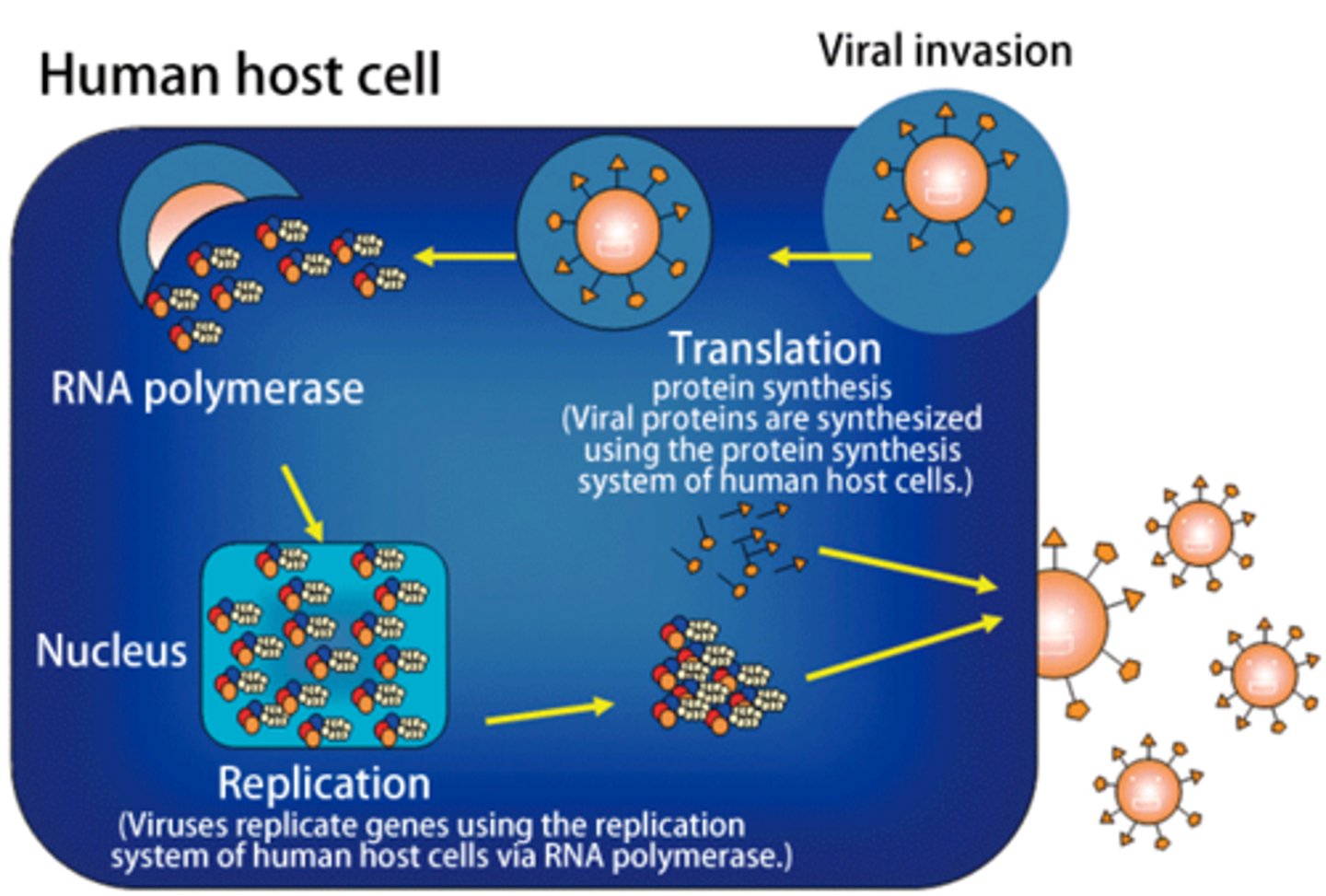
Compare two different processes by which a virus may enter a host cell:
(1) Receptor Mediated Endocytosis
(2) Direct Fusion
Receptor Mediated Endocytosis entails a virus (usually without an envelope) binding to a receptor, which signals to the host cell to envelope it in the membrane and bring it in via endocytosis.
Direct Fusion entails a virus with an envelope simply fuses its own envelope with the host cell's membrane. The virus essentially lets itself in.
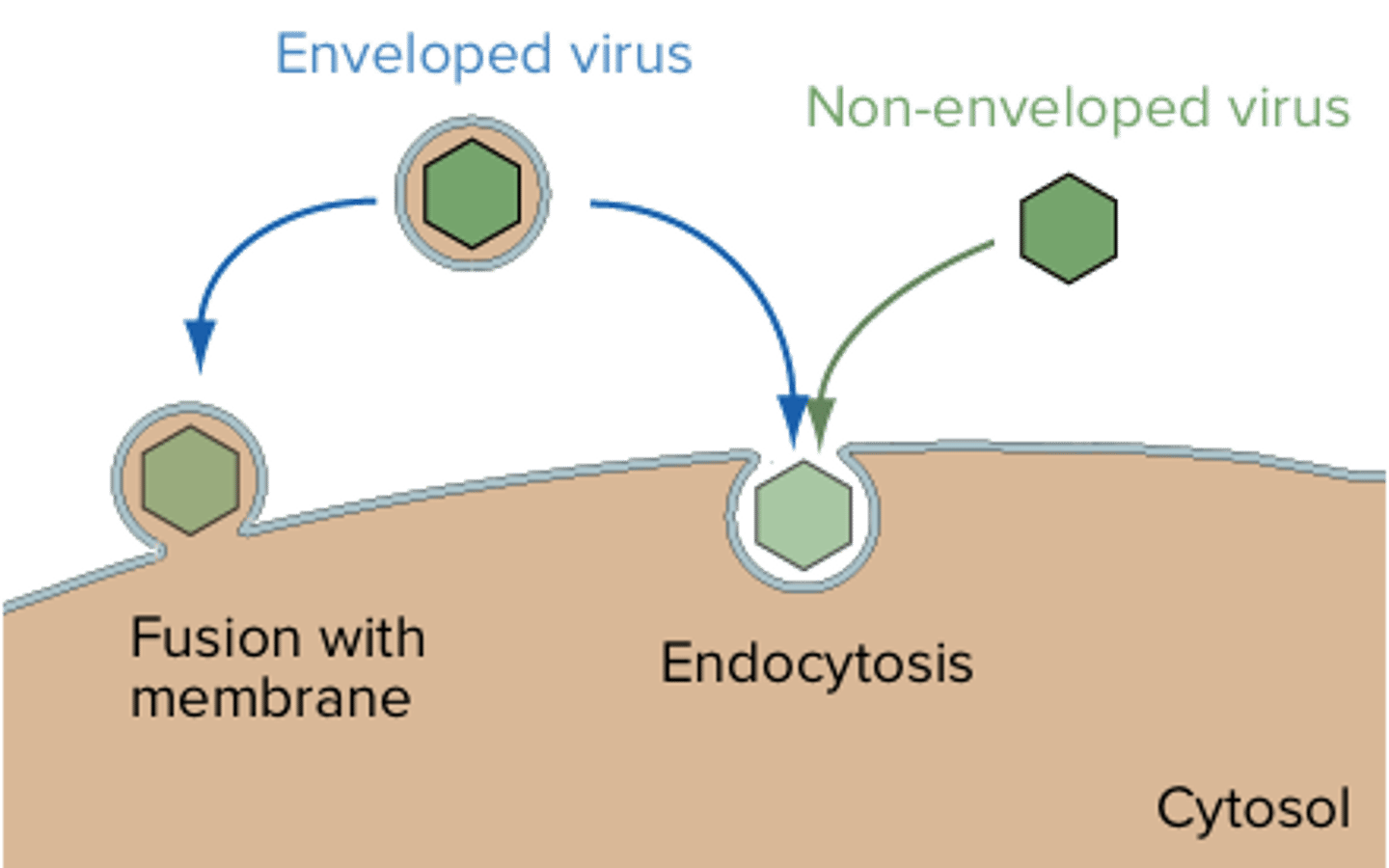
Compare the Lytic and Lysogenic Cycles of Viral Replication.
In a Lytic Cycle, the virus uses the cell's machinery with no regard for the cell, ending with the host cell lysing.
In a Lysogenic Cycle, the virus integrates itself into the host genome, and can remain dormant until environmental factors make this virus return to a Lytic Cycle.
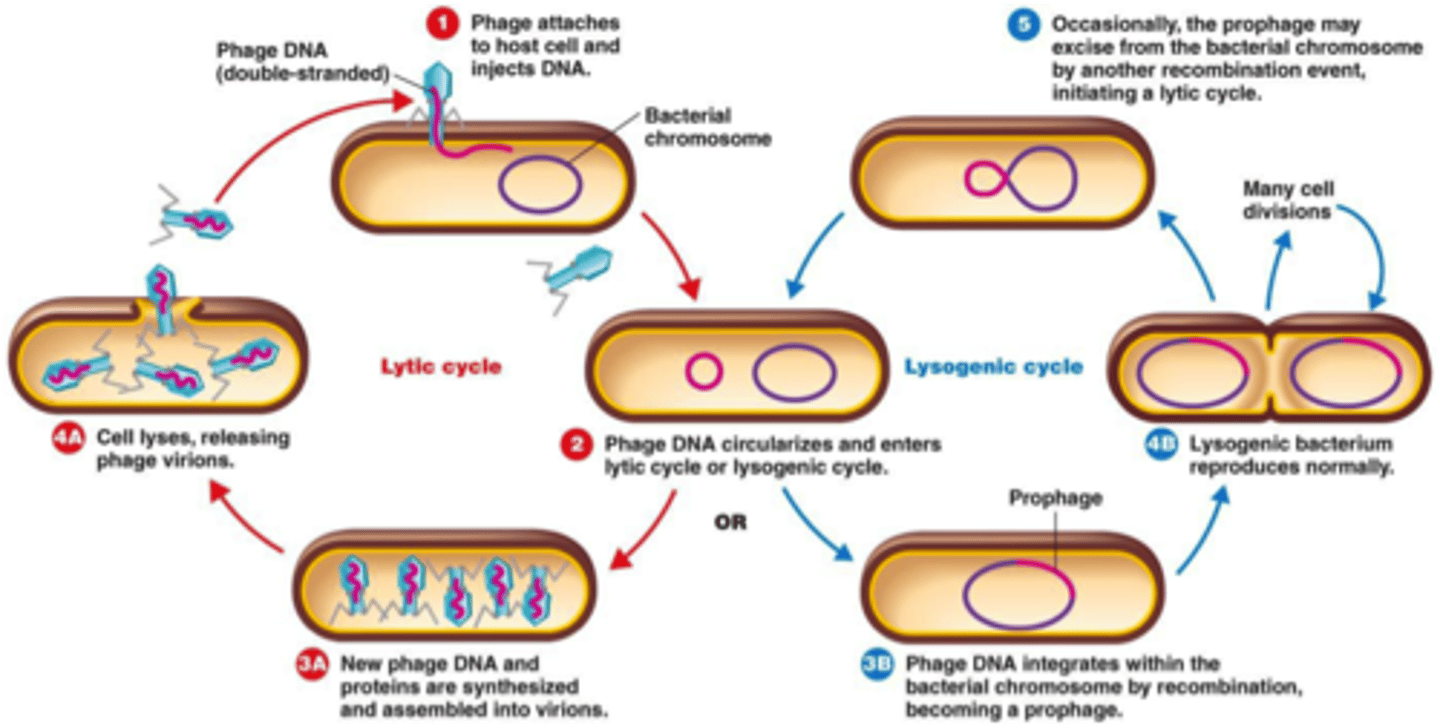
CRB Compare Positive Sense and Negative Sense RNA Viruses, focusing on how they have their genomes transcribed.
(+)-Sense RNA viruses have their genome directly translated to functional proteins by the host's Ribosomes, like the cell's mRNA.
(-)-Sense RNA Viruses need to have their genomes replicated by an RNA Replicase before they can be translated.

CRB True or false? The Negative Sense RNA Viruses can use an RNA Replicase enzyme from its host.
False. The Negative Sense RNA Viruses must use an RNA Replicase that the virus itself carries.
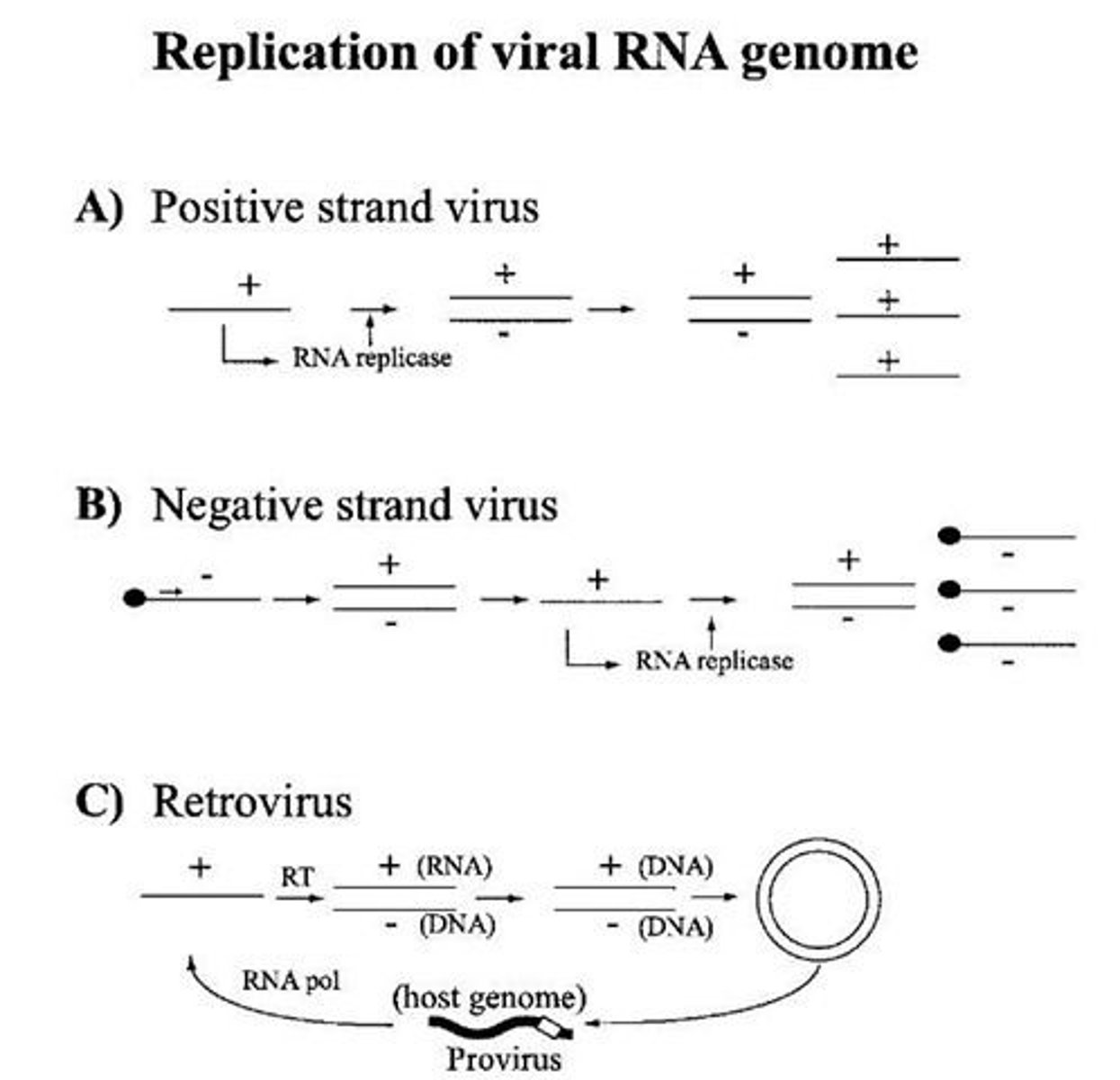
Which of the following best characterizes a Retrovirus?
(A) Enveloped, has ssRNA
(B) Nonenveloped, has dsRNA
(C) Enveloped, has ssDNA
(D) Nonenveloped, has dsDNA
(A) Enveloped, has ssRNA
A Retrovirus is enveloped and has ssRNA.

A Retrovirus contains what three special proteins?
(A) RNA Replicase, Integrase, Protease
(B) Reverse Transcriptase, Nuclear Permease, Protease
(C) RNA Replicase, Nuclear Permease, Protease
(D) Reverse Transcriptase, Integrase, Protease
(D) Reverse Transcriptase, Integrase, Protease
A Retrovirus contains Reverse Transcriptase, Integrase, and Protease
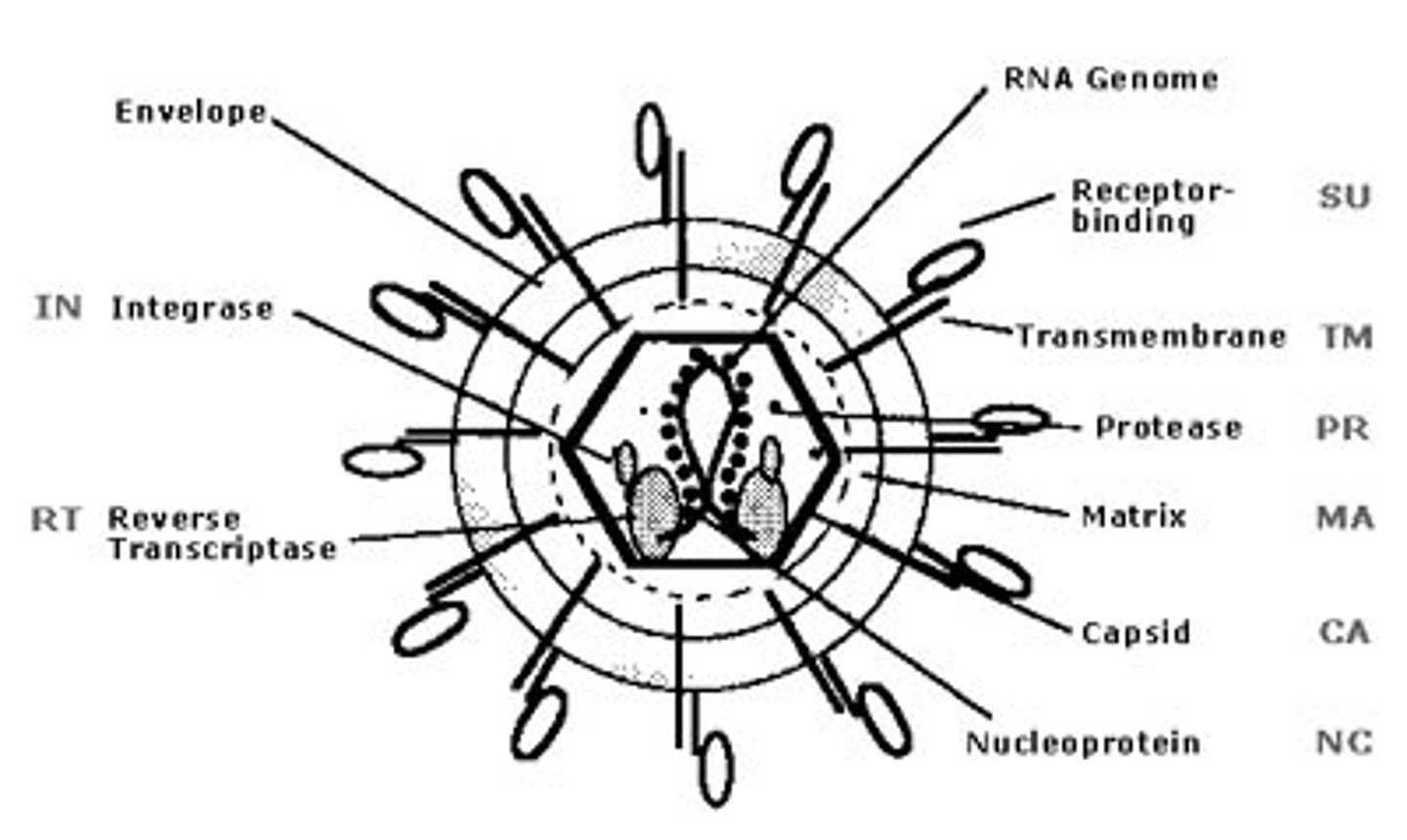
Describe the process by which a Retrovirus enters the host cell and reproduces more viruses. Be sure to include the role of Reverse Transcriptase, Integrase, and Protease.
(1) The Retrovirus enters the cell via either Receptor-Mediated Endocytosis or Direct Fusion.
(2) The Retrovirus goes through the uncoating of its capsid.
(3) Reverse Transcriptase produces a double-stranded piece of cDNA using the ssRNA of the Retrovirus as a template.
(4) Integrase clips off the 3' ends of the cDNA and then integrates it into the host's DNA in the Chromosome.
(5) The host will then actively transcribe this DNA into RNA.
(6) The RNA will be translated into viral proteins, which will then self-assemble into immature viruses.
(7) Immature virus will bud off (exocytosis), gaining an envelope.
(8) Immature viruses mature as protease cleaves the other proteins, Reverse Transcriptase and Integrase, activating them.

Subviral Particles and Viruses are together termed "nonliving infectious agents." Compare the two main types of Subviral Particles: Viriods and Prions.
Viriods are small pieces of circular RNA that can self cleave to create more of themselves.
Prions are small misfolded proteins that can cause normal proteins to misfold (α-helices will become β-sheets).
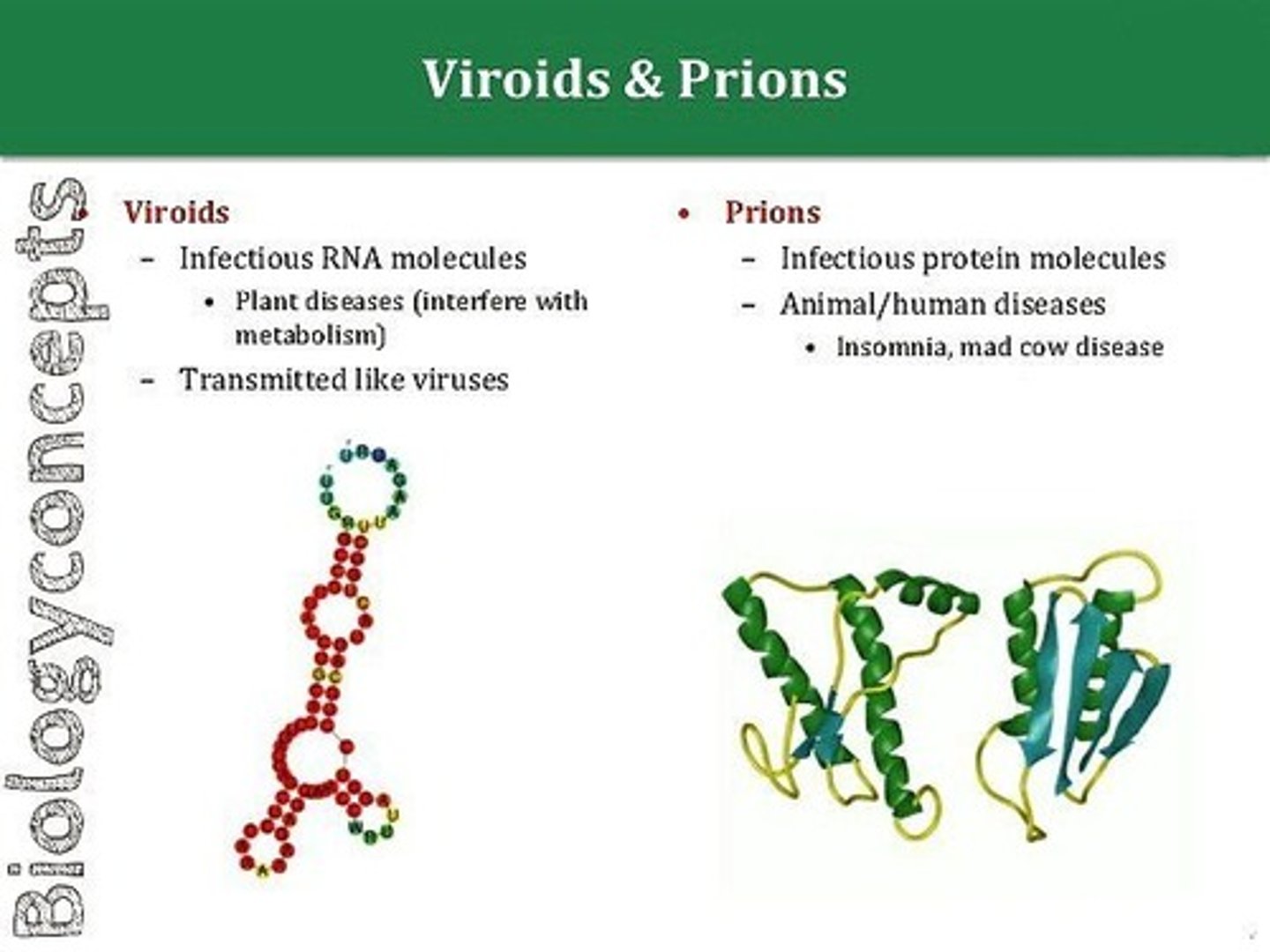
Viriods and Virions are commonly mixed up. What's the difference between these two things?
Viriods are small pieces of circular RNA that can self cleave to create more of themselves.
Virions are mature viruses that are complete with a capsid. They have not entered a host and undergone uncoating yet.
